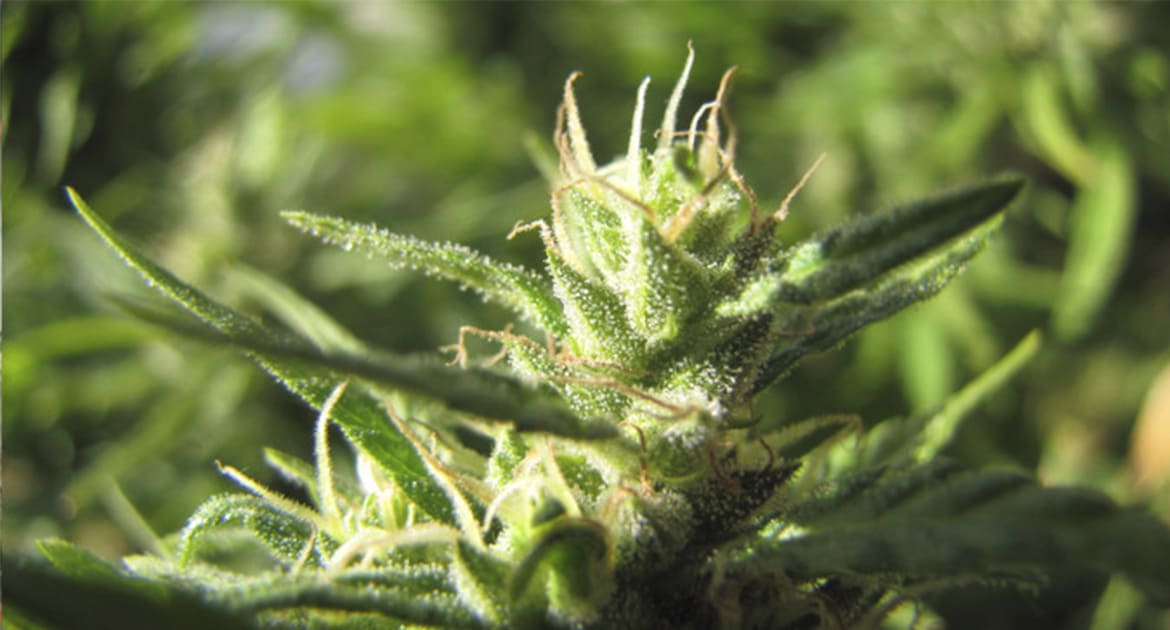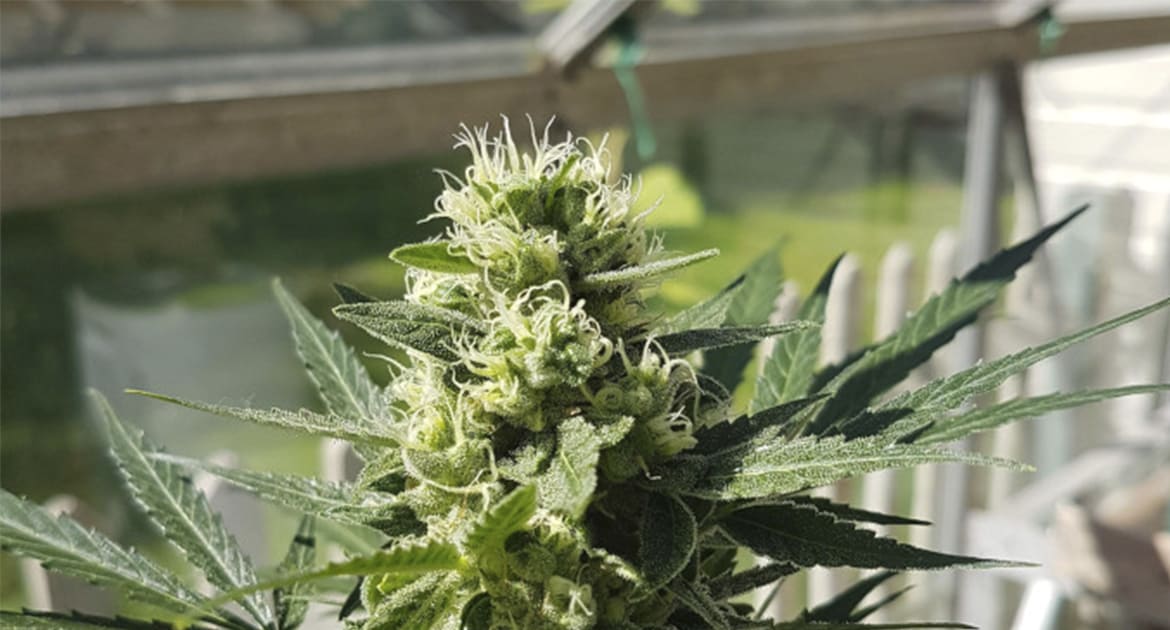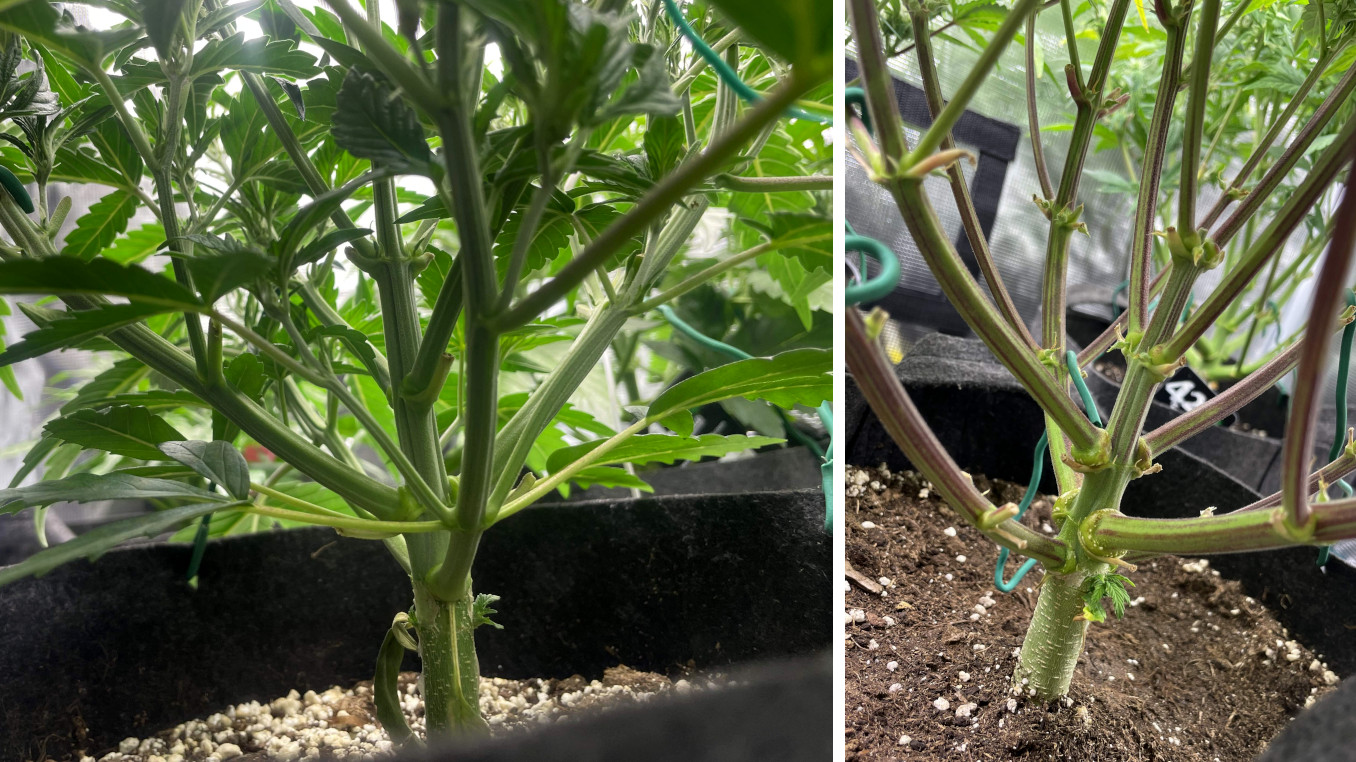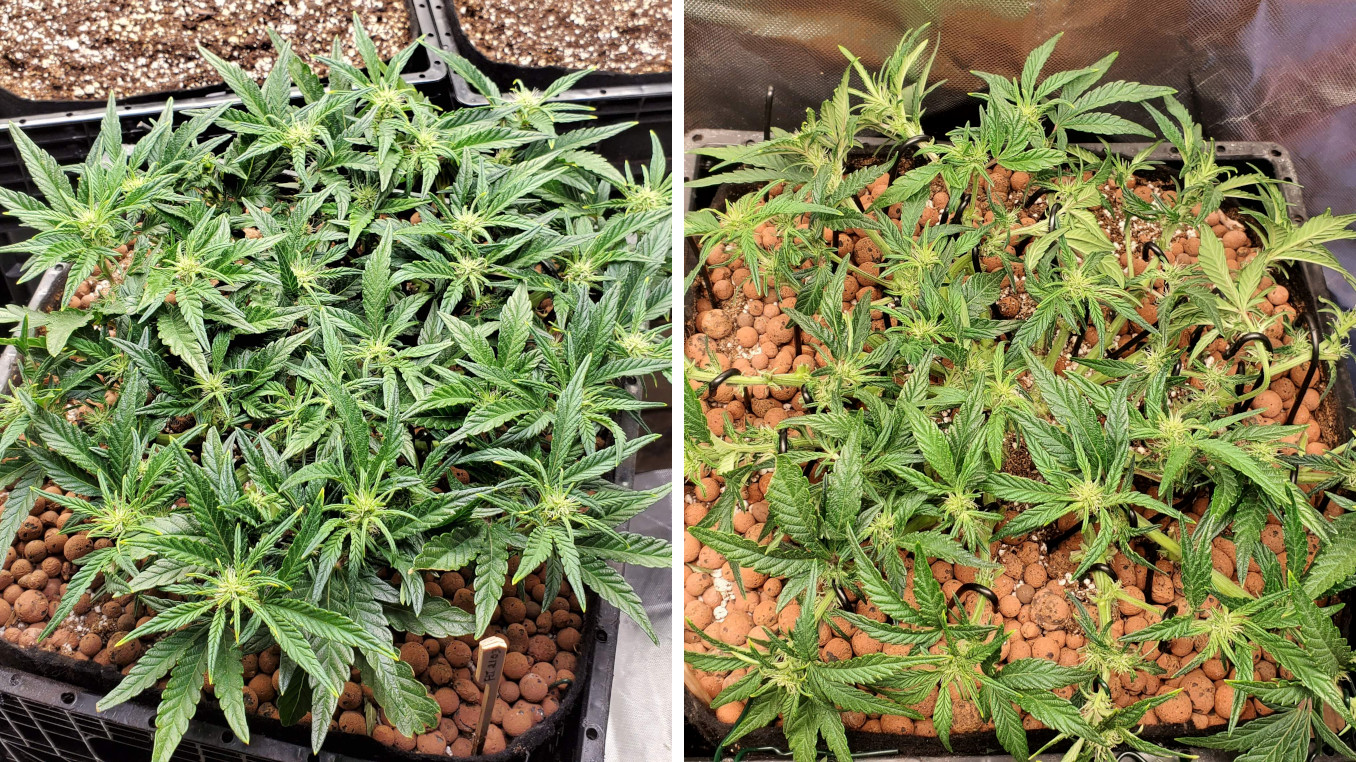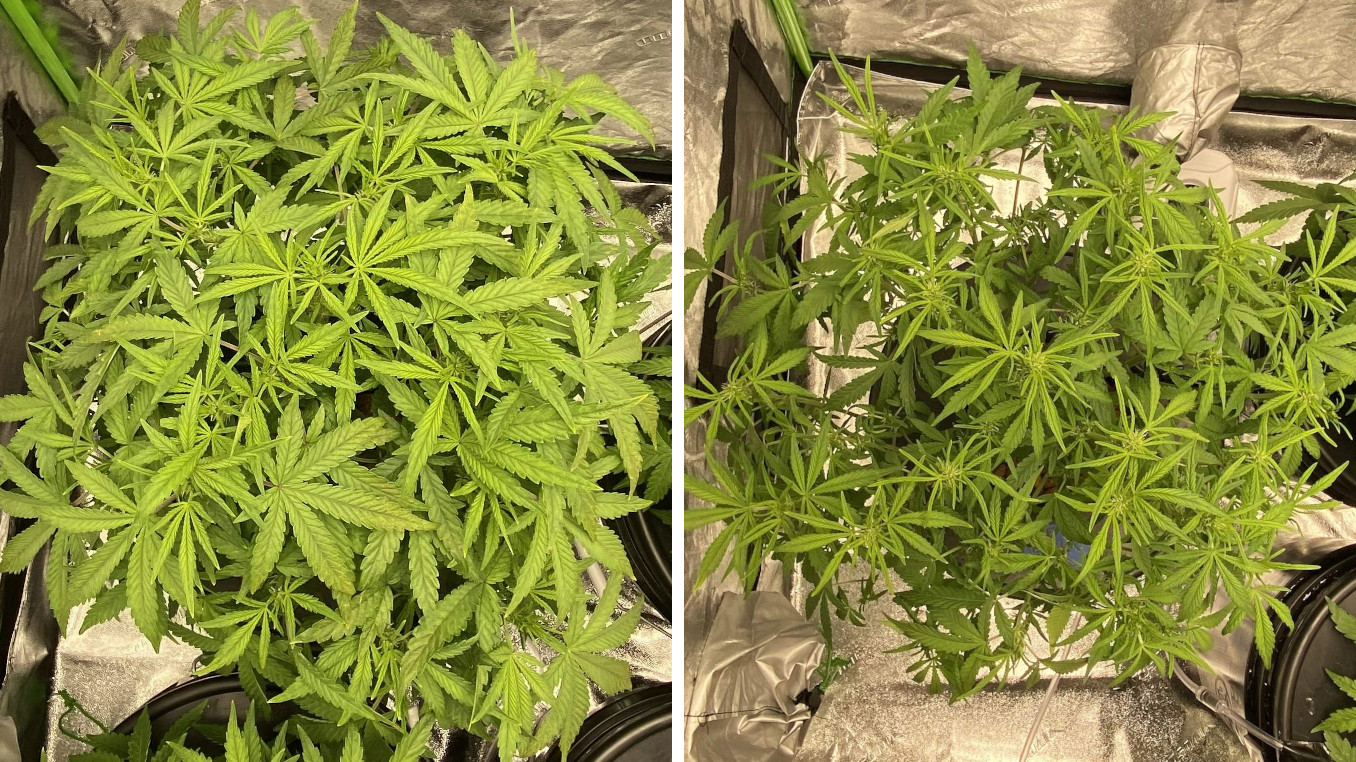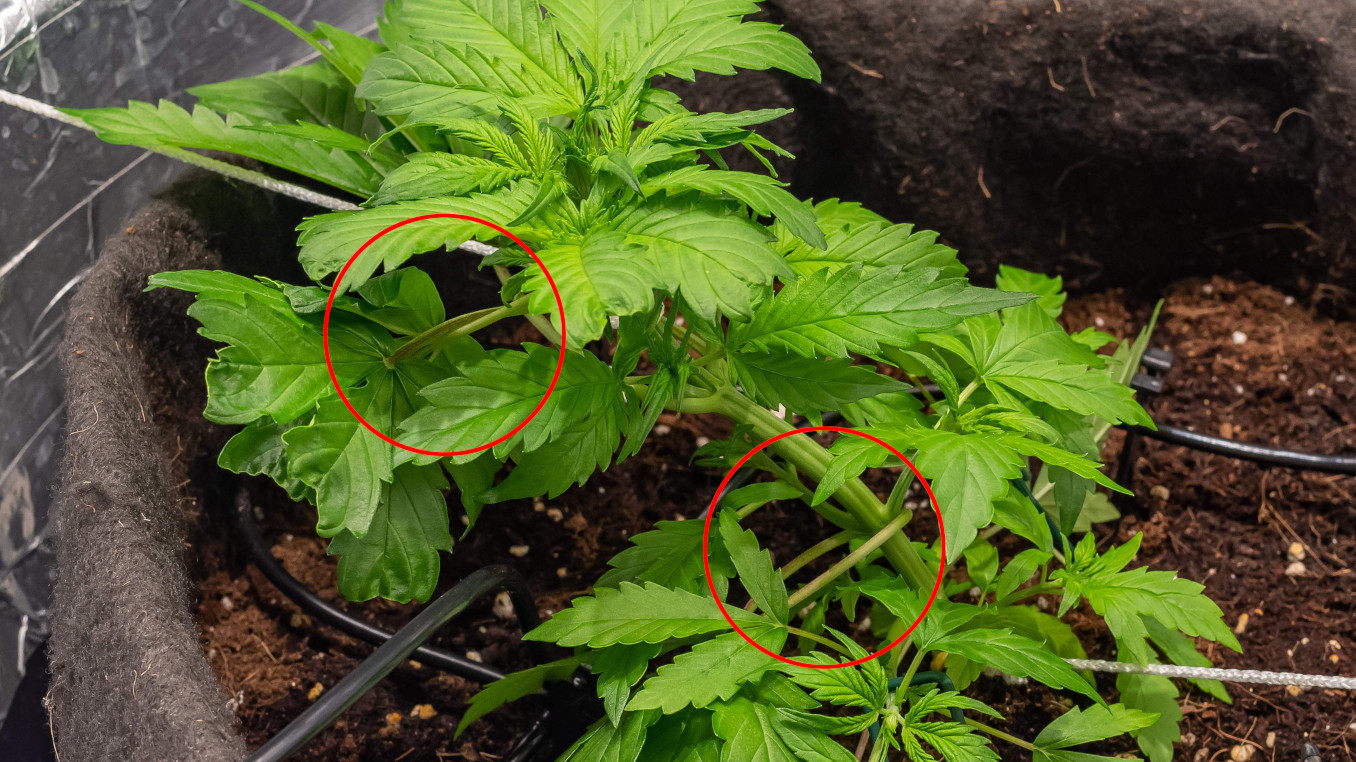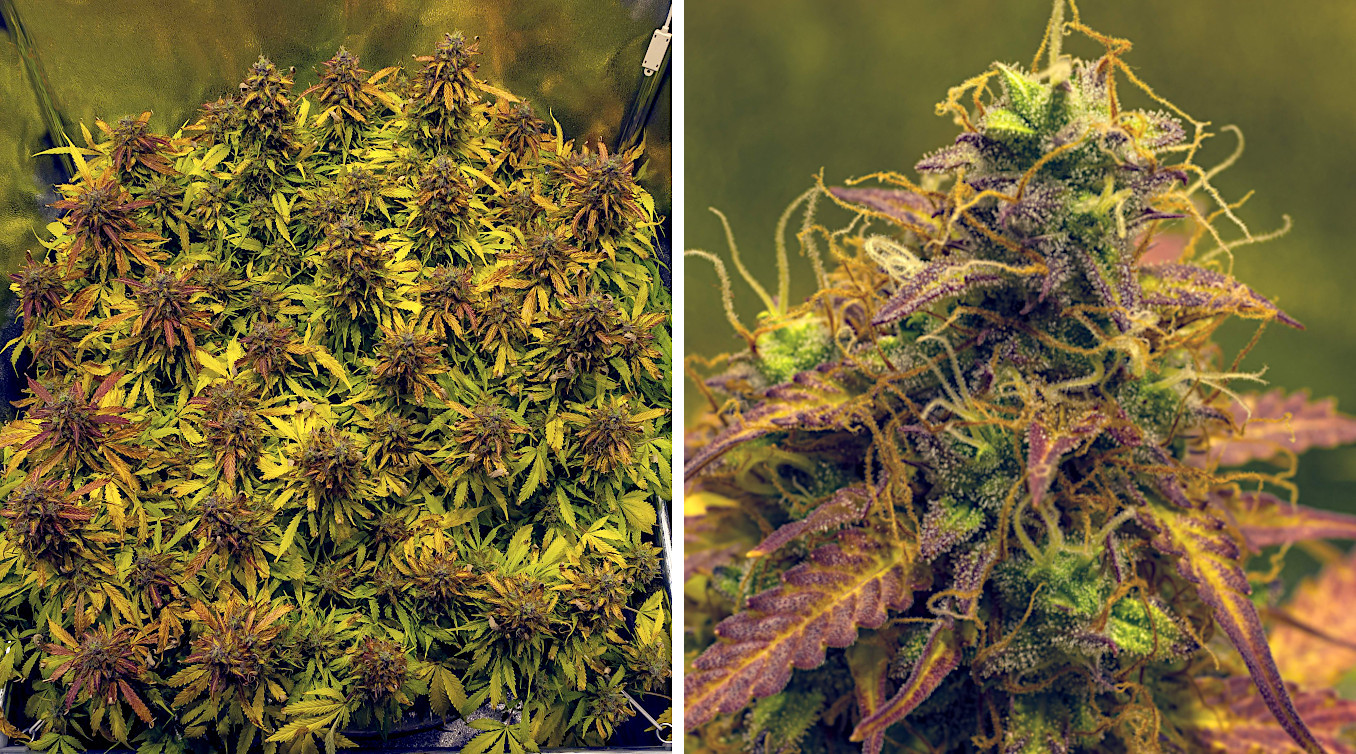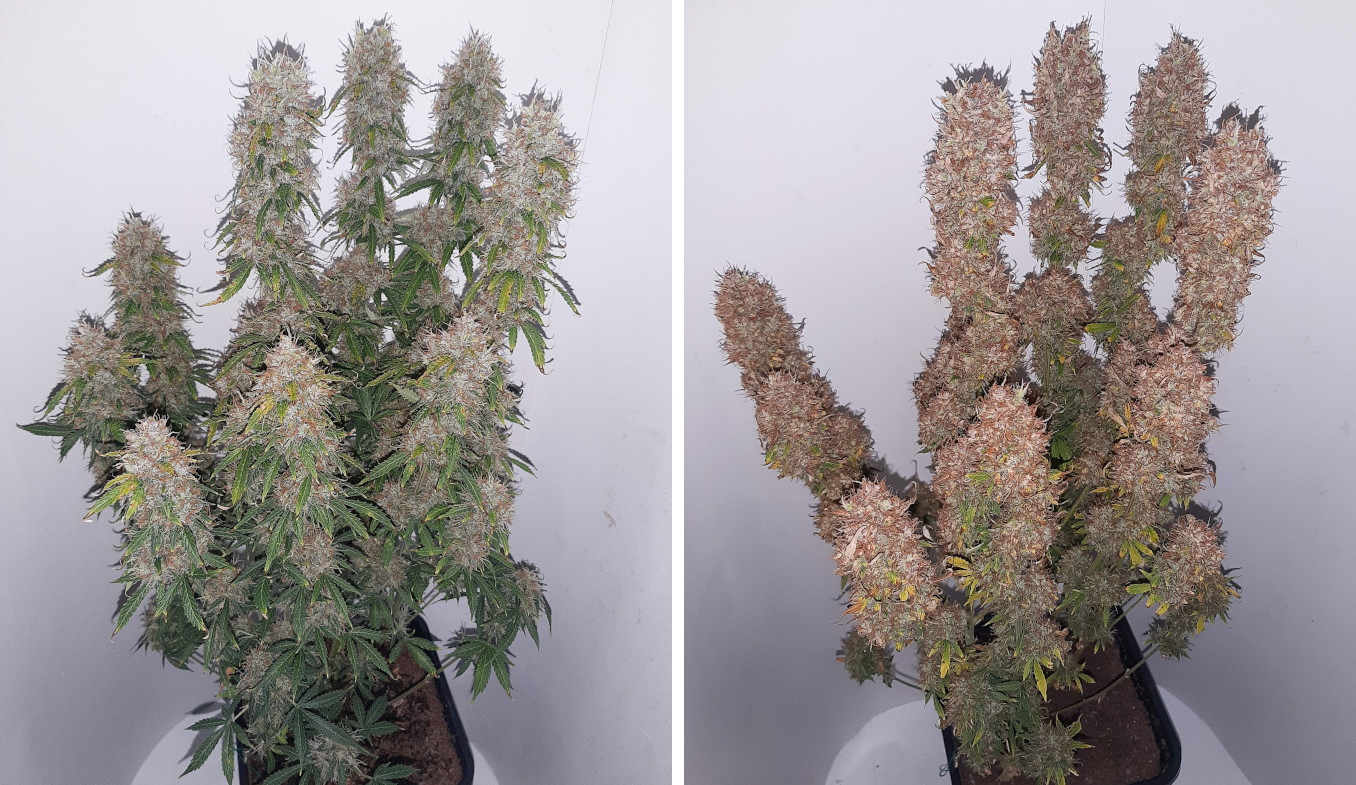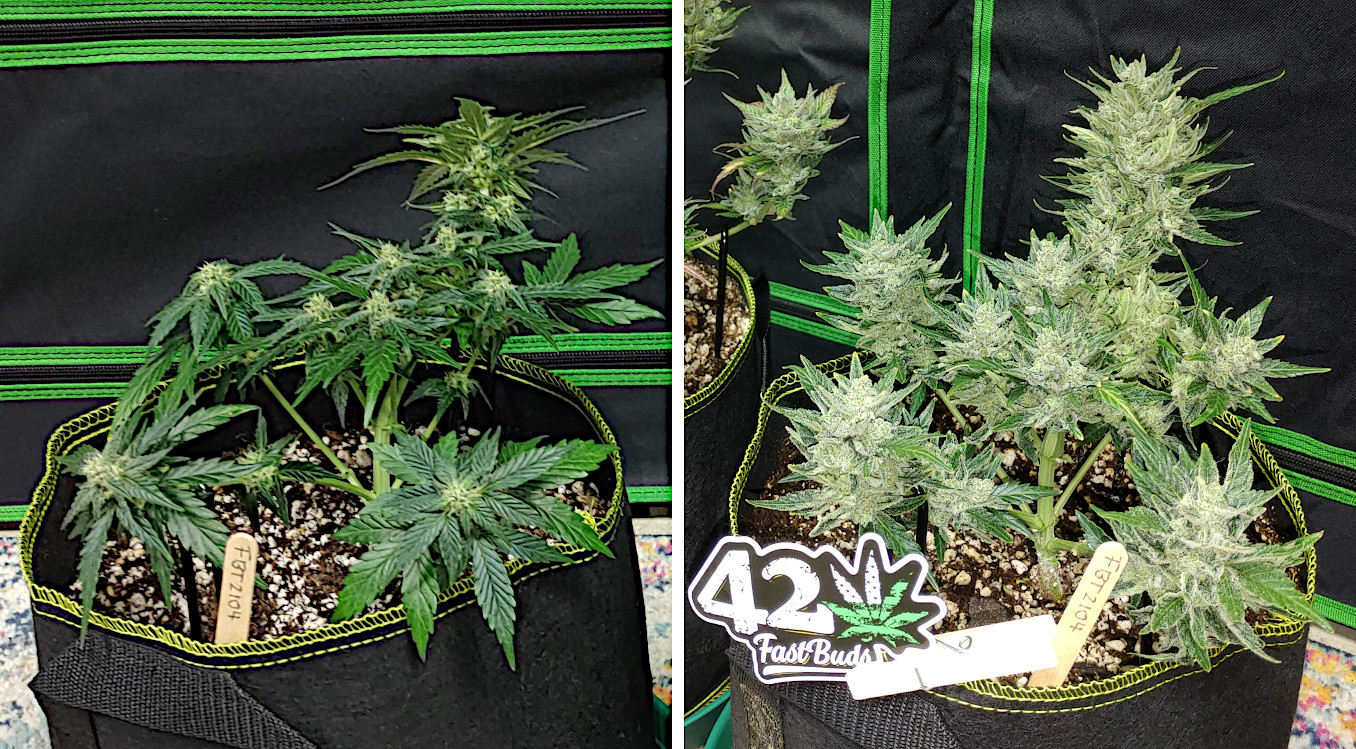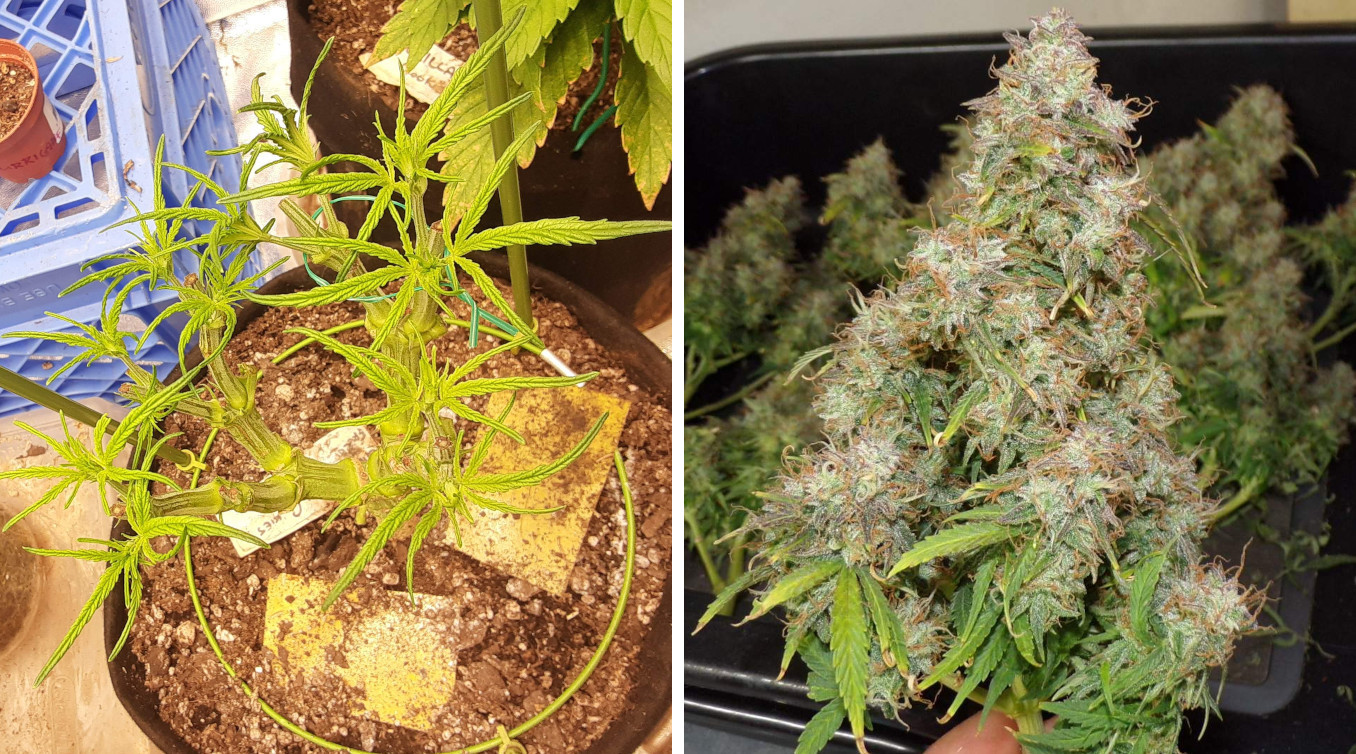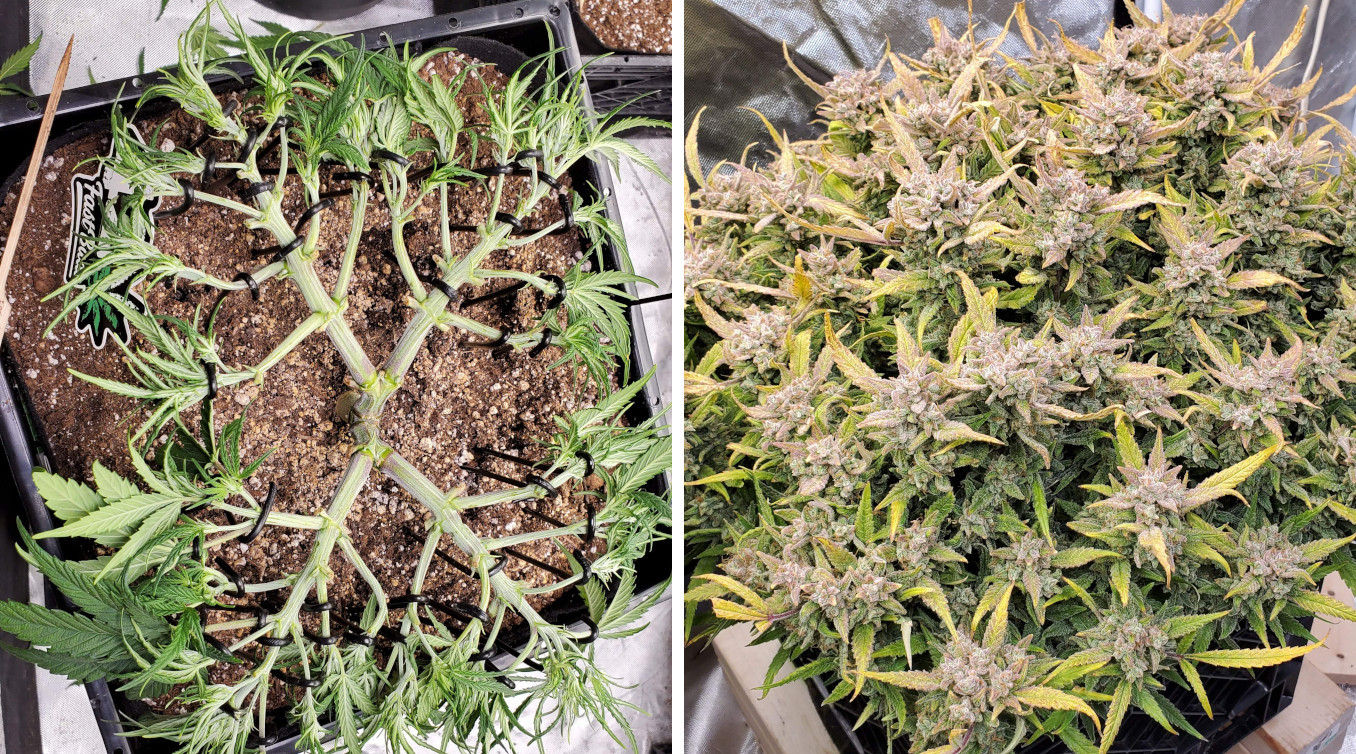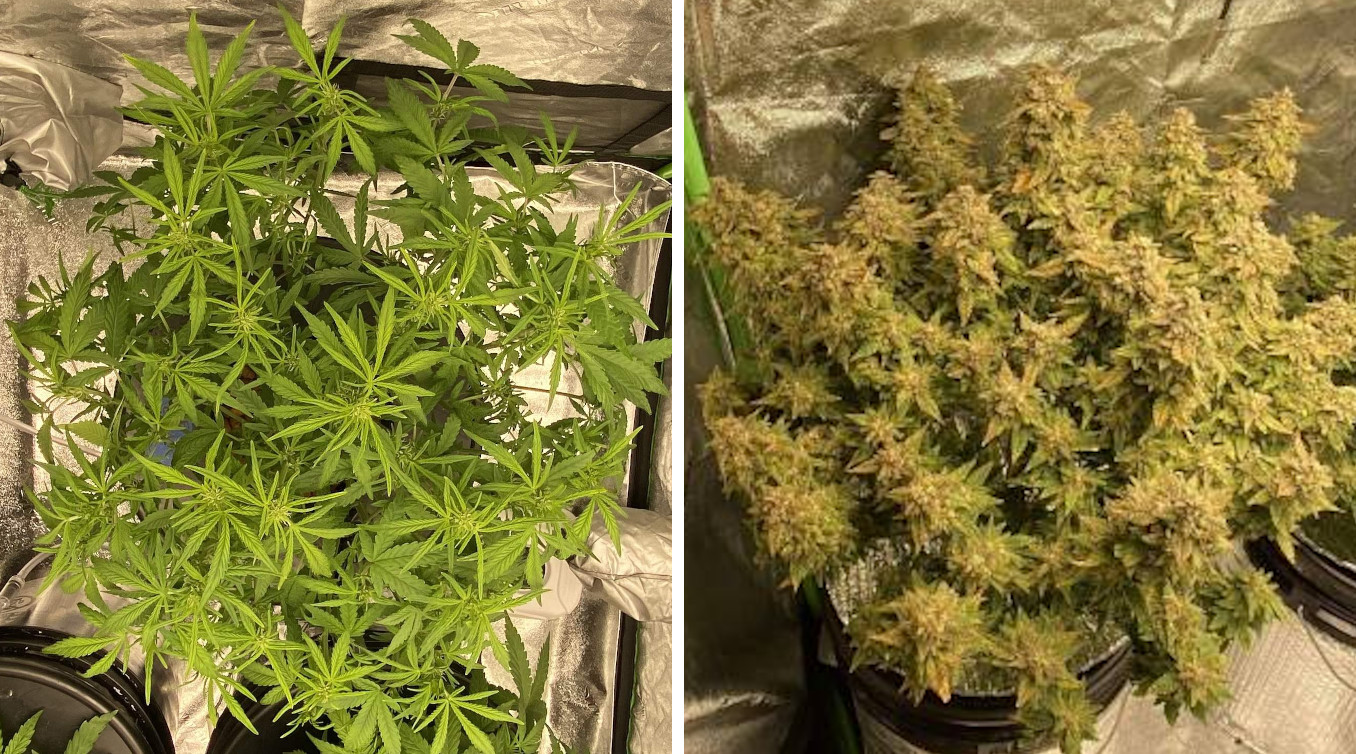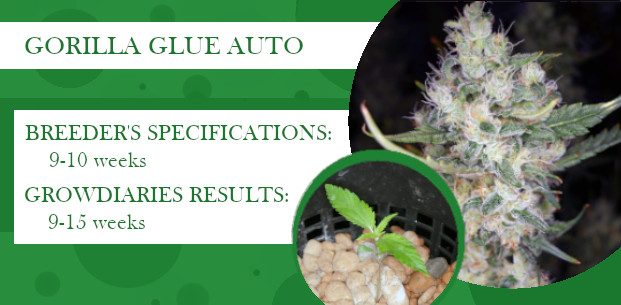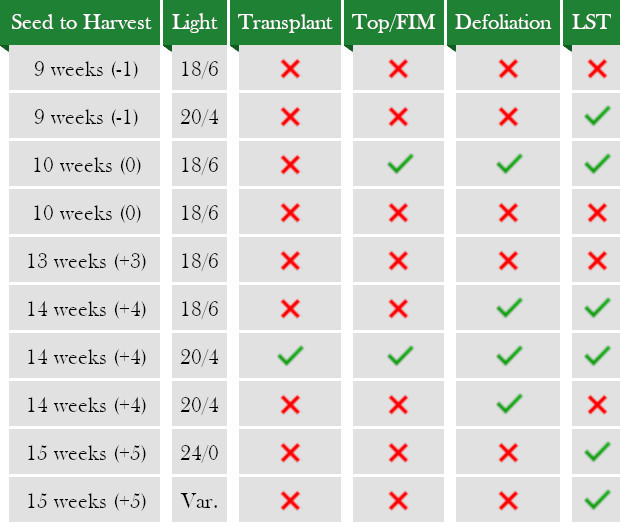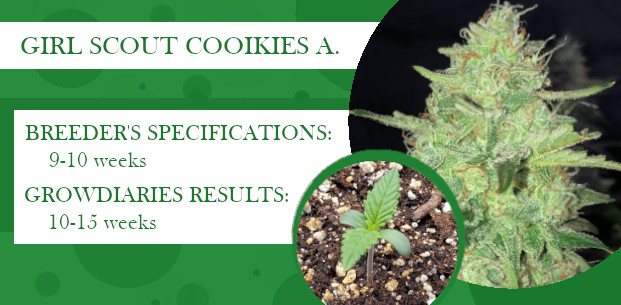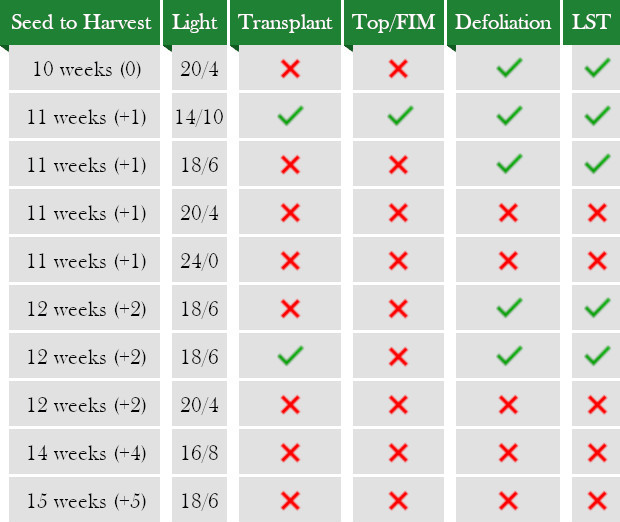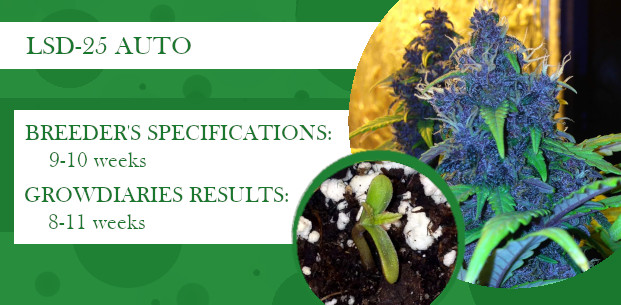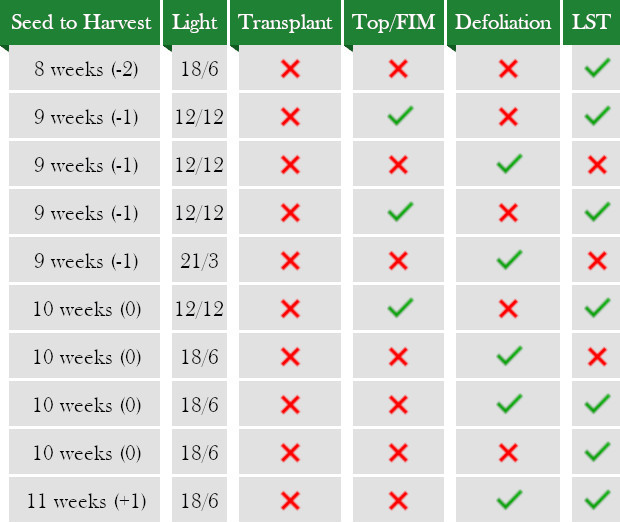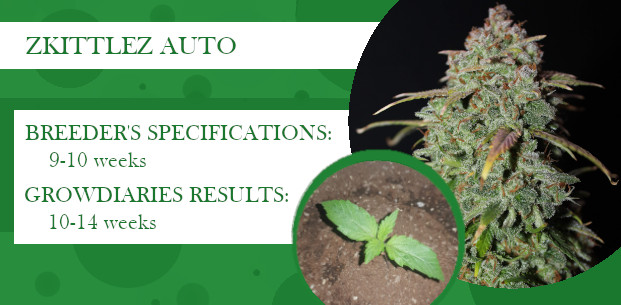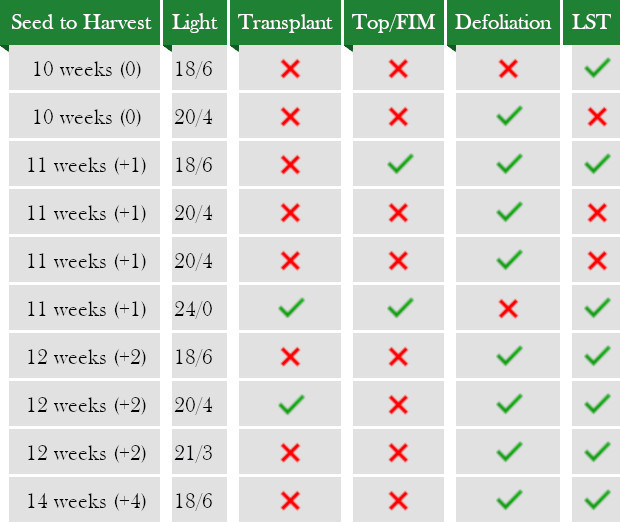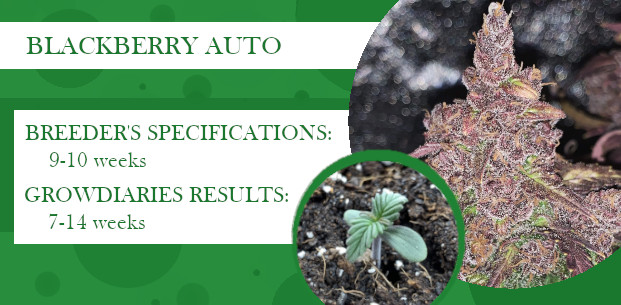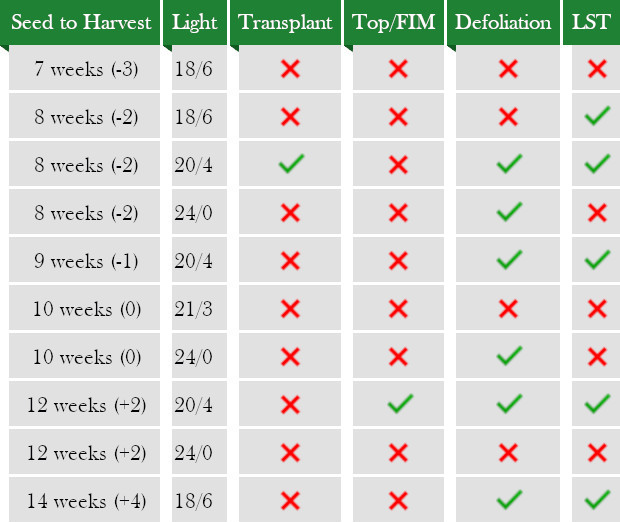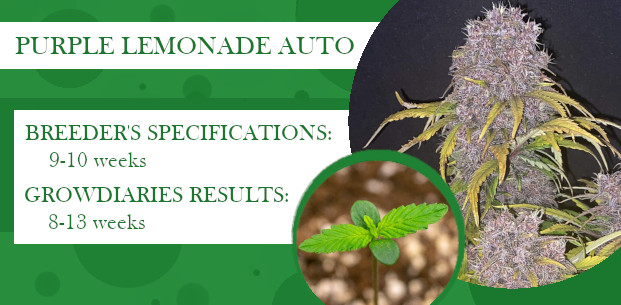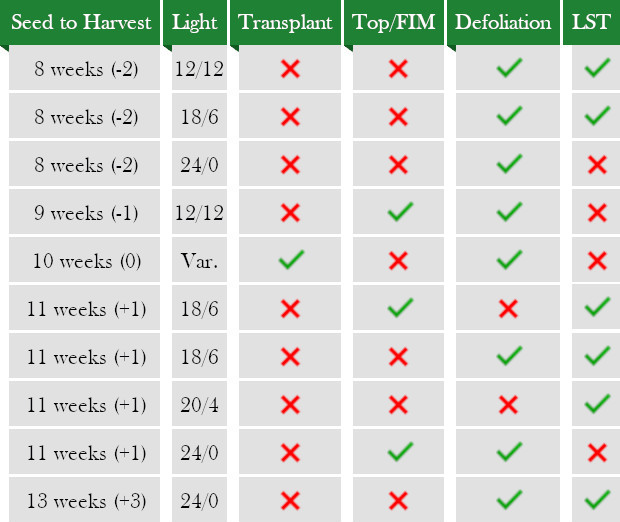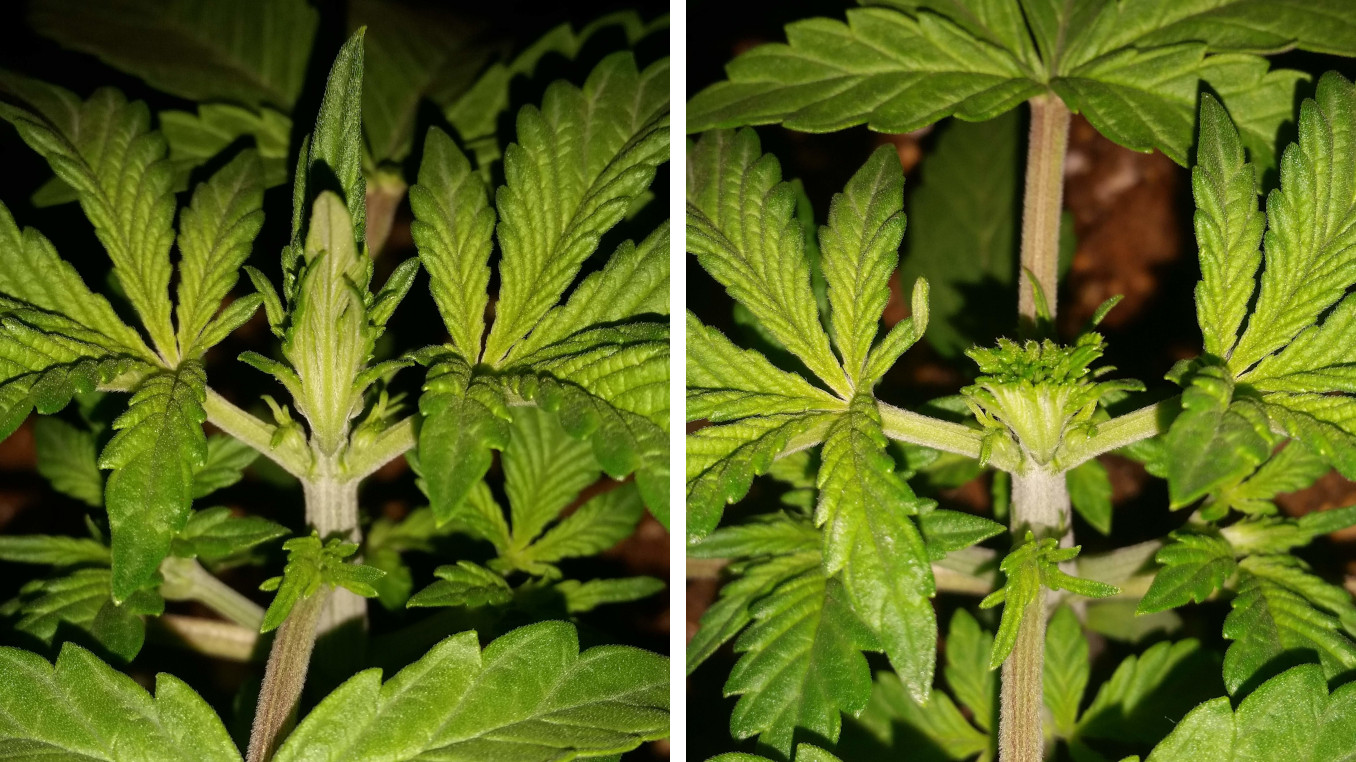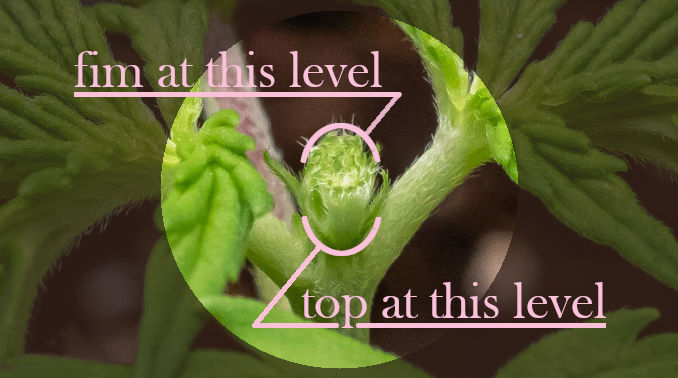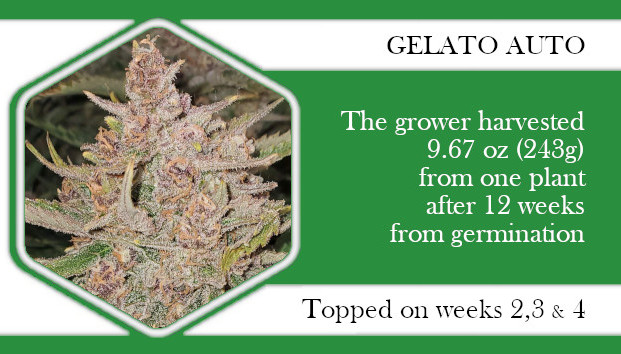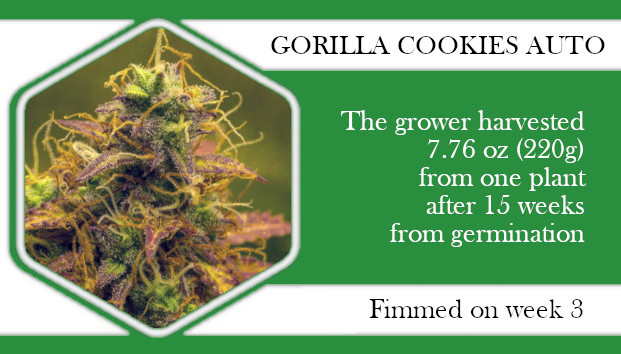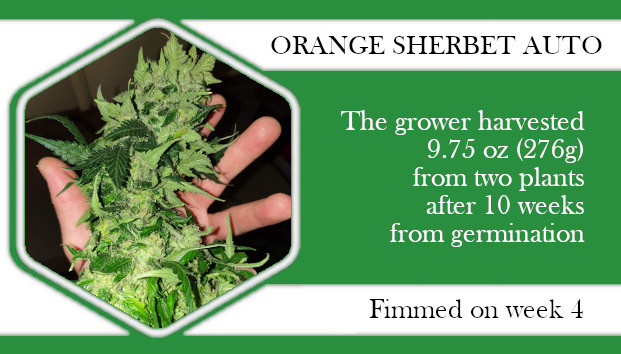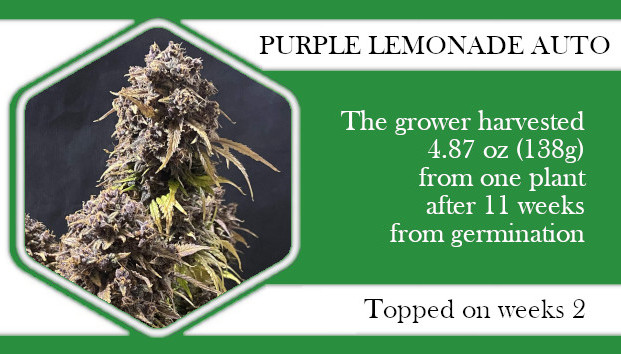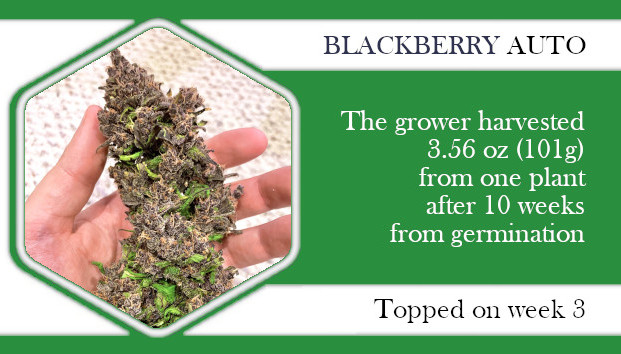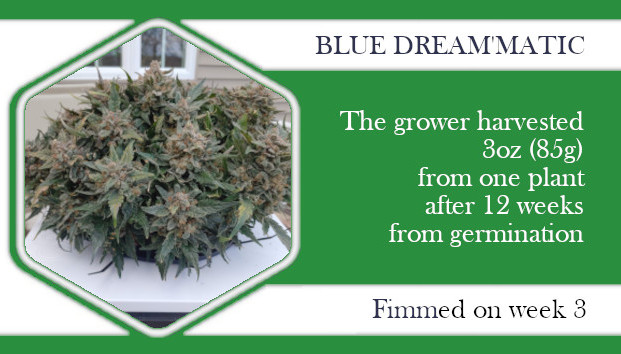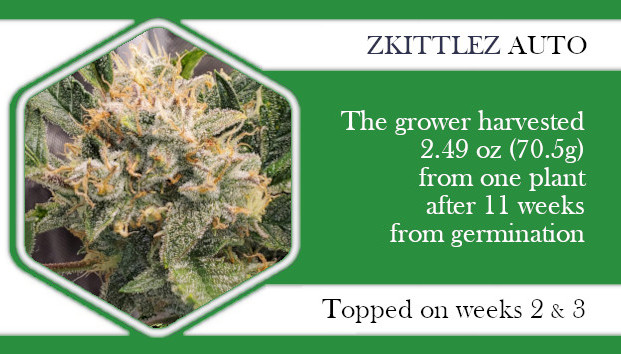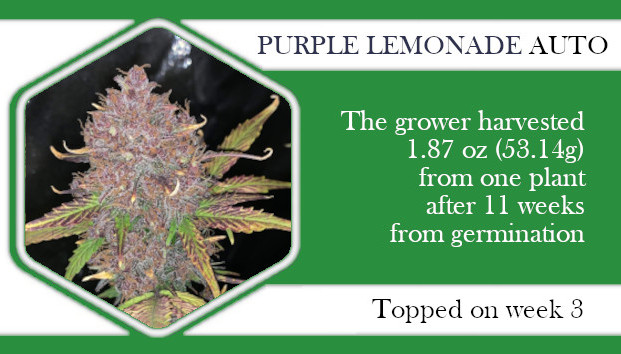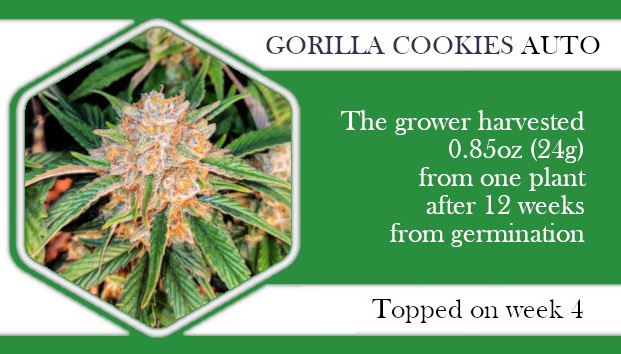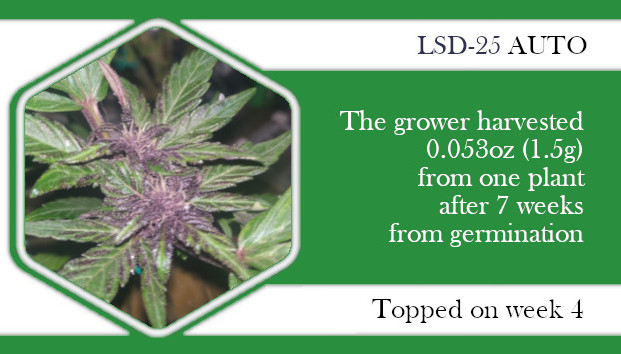Most of you know how important it is to control the temperature in your weed garden. You also understand that when it’s too hot for too long, the plants will begin to suffer and show you exactly what’s wrong with them. The trick is knowing where to look. In this post, we’ll talk about how the symptoms of cannabis heat stress look like so that you don’t mix’em up with other issues and take proper action right away.
- you can notice symptoms of cannabis heat stress on both leaves and buds
- leaves start to cup (curl up) and later become brown and burned
- in flower, buds may start to foxtail
- control the distance from the light and set up proper ventilation
- maintain the right temperature in the root zone
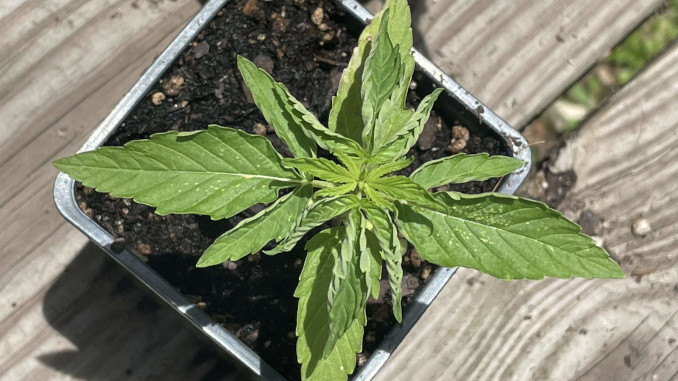
A young plant suffering from heat stress. © Growdiaries © Sandero
Experienced cannabis growers recognize signs of heat stress right away. Heat stress may affect leaves as well as buds.
Symptoms of Heat Stress on Leaves
It all starts when those sharp points on the leaf edges begin to curl up. Thereby, the plant tells you that it has become too hot.
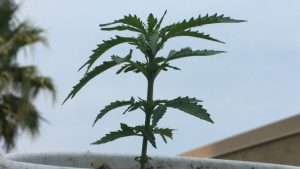
And if you don’t resolve the heat issue soon, the leaves curl up even more and start to look like tacos.
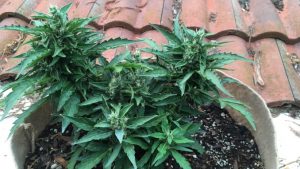
It’s hard to say why it happens. Maybe that’s how the plant tries to reduce the surface that receives light.
In an indoor setup, leaf cupping often happens on the parts of the plant that are closest to the bulb. It’s because they receive too much radiant heat from the light. And farther down the stem, leaves may remain normal.
And sometimes, only SOME of the upper leaves show these symptoms — where the light creates hot spots.
Of course, during a heatwave, your whole grow room can get too hot. Then you may notice signs of heat stress on both upper and lower leaves.
Let the problem persist, and you’ll see the situation get much worse. The leaves may get yellow and then brown. The discoloration starts at the tips and along the edges. Later, the heat burn spreads to the whole leaf, and eventually, the leaf becomes dry and crispy.
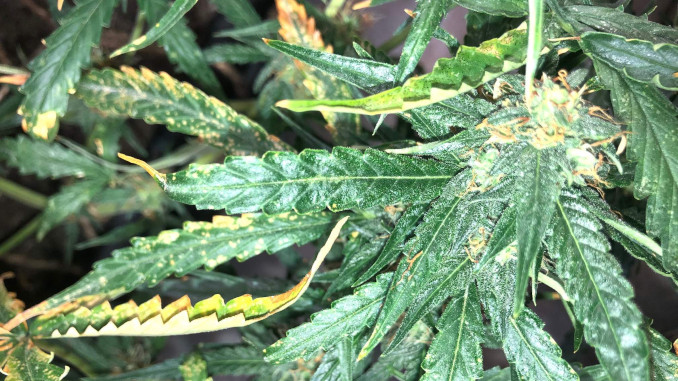
Don’t Confuse Cannabis Heat Stress and Calcium Deficiency
It’s easy to confuse the signs of cannabis heat burn and the symptoms of calcium deficiency. Calcium-deficient leaves also have brown spots and may become dry and brittle at the tips and along the edges, but they also twist in every direction.
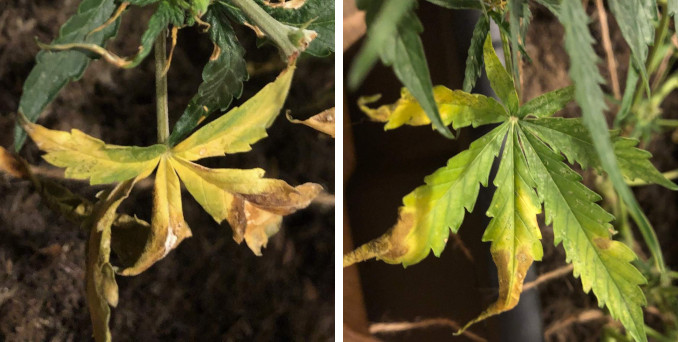
Of course, there are situations when plants have both these issues at the same time. Calcium deficiency makes the plants more vulnerable to heat stress, and heat stress makes the calcium-deficient leaves dry out faster.
Droopy Leaves
Droopy leaves aren’t a sign of heat stress. Rather, they indicate that the plant is thirsty. So, if you see that the leaves on your cannabis hang lifeless, maybe it’s time to water your garden. And don’t forget to water more often when the temperature in your grow room rises.
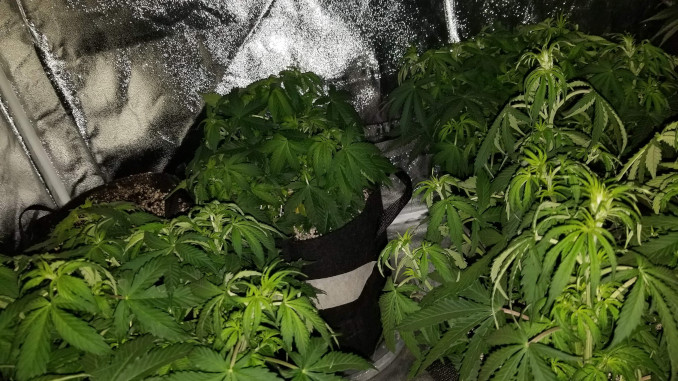
Btw, droopy leaves aren’t a very specific symptom. So, it’s easy for inexperienced growers to confuse underwatered wilting and overwatered “claws”. Besides, leaves may slightly droop every evening (before lights-out), and it’s perfectly normal.
Light Stress
Both light stress and heat burn often stem from the same problem — the light being too close to the plant tops. Though these two may manifest at the same time, they are different issues. With good ventilation, you may have an ideal air temperature in the grow tent (and no heat stress), but your plant tops will still suffer from too much light.
Light stress starts with the yellowing of the leaves. Please note that usually, it’s not the youngest leaves on the very top that start to yellow, but the ones just below them. It’s because they have been exposed to light a day or two longer and so get affected earlier.
Light stress is a very common issue in seedlings. Growers often think it’s potassium deficiency and try to treat it as such, but all they need to do is raise the light.
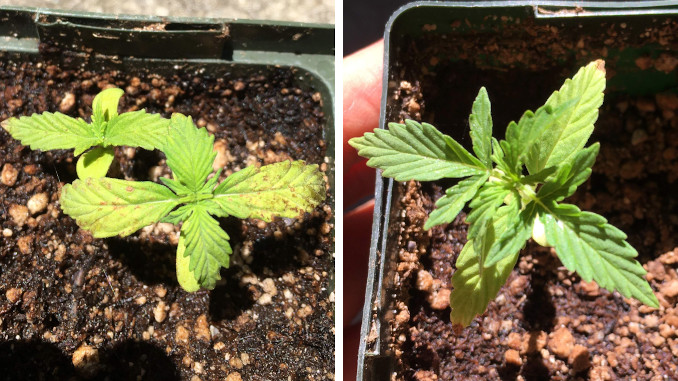
Symptoms of Heat Stress on Flowering Buds
Extreme temperature can damage flowering weed plants in several ways. It can interfere with the production of THC and terpenes, making your smoke less potent, aromatic, and flavorful. It can also lead to lower yields because heat prevents buds from filling out and they remain airy and spongy. In a worst-case scenario, buds start foxtailing, especially if you grow one of the strains with a tendency to foxtail.
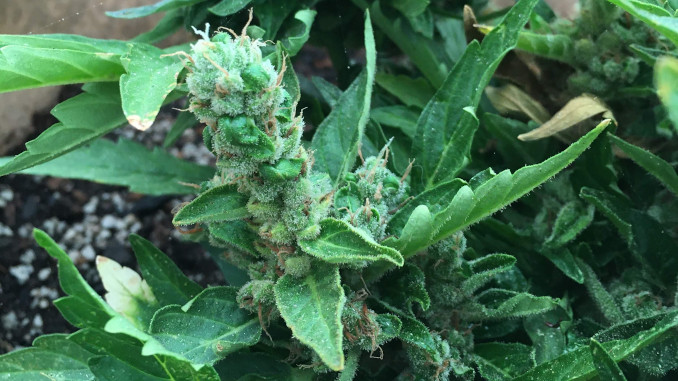
If the heat is extreme—even for a short period of time—the pistils may change their color from white to brown prematurely. Pistils are the female hairs on cannabis buds. It’s normal for them to become amber or brown at the end of the life cycle when the buds are already big and dense. But if the flowers have only begun to form, they should have white pistils.
How Much Heat is Too Much?
Just like humans, marijuana plants can tolerate very high temperatures for a short time. The problems begin when the temperatures are consistently above optimal levels. You may ask: what are those optimal levels?
Well, we’ve covered that in another article where we cite available research on the topic. In a nutshell, aim for 77-86°F (25-30°C) during the day and 10°F (8°C) lower at night. When the temp levels creep above the allowed maximum, photosynthesis slows down and you begin to notice stunted growth and heat stress symptoms.
And there’s one more thing we didn’t mention earlier: cannabis pests LOVE hot and humid environments and multiply in great numbers.
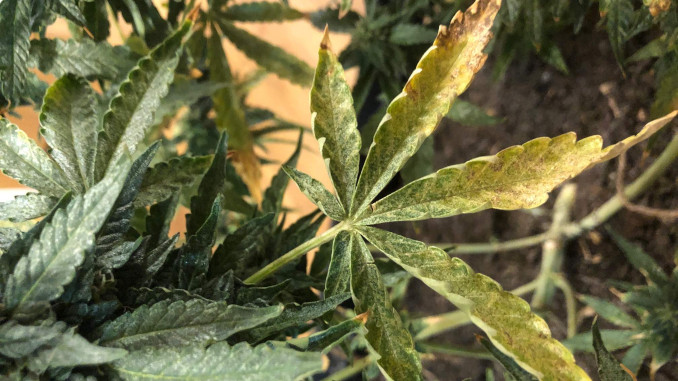
How to Take Care of Heat Indoors
First of all, don’t plan any indoor growing for the summer months. Otherwise, your grow tent will turn into an oven when a heatwave comes. Second, try to use lights that generate less heat. This means LED quantum boards instead of HPS bulbs.
A very clever trick is to run your lights during night hours—when it’s generally cooler—and turn them off for the day. The only issue could be light leaks. They don’t matter if you grow autoflowers, but with photoperiod strains, make sure there are no light leaks at the seams. Otherwise, they can disrupt flowering.
You can also try and raise the levels of CO2 to help cannabis deal with heat stress. For example, you can place CO2 bags in your grow tent. Please bear in mind that this method is controversial. Available research in other crops draws a very complicated picture. Sometimes, more CO2 is helpful in dealing with high temps, and sometimes it hurts plants even more.
Clearly, the most important thing is ventilation. Your extractor fan should refresh the air inside your grow space at least once every 3-5 minutes. And if you think problems with heat are possible, make it every minute. The same goes for small grow tents. The smaller your tent is, the easier it is to overheat.
So, calculate the volume of the grow tent in cubic feet, write down this number, and buy a fan with the same CFM (the cubic-feet-per-minute capacity).
Also, install an oscillating fan that will blow just above the canopy level. It will help protect your plant tops from heat burn.
The Temperature in the Root Zone
Hydroponic growers know very well the importance of keeping the roots nice and cool. If the temperature of the nutrient solution gets way above the recommended 65°F (18°C), problems begin. The levels of dissolved oxygen go down, and the pathogens thrive.
The temperature in other mediums, such as soil or coco, is just as important, but soil growers often forget about it and learn how important that is the hard way.
So, when growing weed under powerful bulbs indoors, make sure to shade your pots from the light. Especially if the pots are black and thus absorb the radiant heat easily. For the same reason, it’s safer to use terracotta containers with thick massive walls than thin plastic ones. And when watering your plants, be sure to use water that is not too warm.
Important! Even if the temperature of the air is way off the mark but the temperature in the root zone is within the ideal range, the plants will be perfectly healthy and show no signs of cannabis heat stress.
Measures Against Cannabis Heat Stress Outdoors
Outdoors, you can help your weed garden deal with heat in three ways:
- Keep the roots cool.
- Shade the plants from the sun during the hottest part of the day.
- Help them survive a heatwave with regular watering.
If you grow cannabis outdoors in pots (rather than on beds), make sure the containers themselves don’t receive any direct light. And when the plants grow in the ground, use a lot of mulch to cover the ground and thus insulate it from heat.
In a hot and sunny climate, plant your cannabis in a spot where trees or walls shade them for a couple of hours in the afternoon. However, a more efficient way is to plant your garden in an open spot and spread shade cloth over it when necessary. And if you grow weed in pots, you can move them around, chasing either the sun or the shade as needed.
Watering your garden generously each morning will help the plants deal with the heat. And if the water is cool, it will not only provide moisture but also lower the temperature in the root zone.
Can You Revive a Heat-Stressed Plant?
In most cases, all you need to do is adjust the temperature and simply wait for the plant to get better. However, some growers propose more hands-on approaches.
Silica (Silicon Dioxide)
Many nutrient manufacturers offer supplements that contain silica. They claim that silica makes cell walls tougher, and tougher cell walls—among other things—make sure leaves lose less water during extreme heat and drought. There are also other mechanisms of silicon’s effect on heat resistance.
The good news is that research on crops other than cannabis, such as rice and tomatoes, fully supports these claims. Silica really makes higher plants more tolerant of heat.
And this is a list of cannabis growing supplements that contain silica:
- Advanced Nutrients Rhino Skin,
- True Plant Science Silica Gold,
- Botanicare Silica Blast,
- B.A.C. Silica Power,
- NPK Industries RAW Silica,
- Cyco Platinum Series Silica,
- Advanced Hydroponics of Holland Advanced Silica.
Humic Acid
There is ample evidence that humic acid enhances heat tolerance in plants. Researchers have observed these effects in Arabidopsis, tomatoes, and oats. The first of these studies even suggested the exact mechanisms of how humic acid makes plants more heat tolerant. Namely, it regulates several relevant genes, including Heat-Shock Protein (HSP).
Cannabis growers widely use humic acid which is a part of the following products:
- Green Buzz Liquids Humic Acid Plus,
- NPK Industries RAW Humic Acid,
- Earth Juice Rich Humic,
- Guanokalong Black,
- Humboldt Nutrients Hum-Bolt and FlavorFul.
Seaweed Kelp Extract
Seaweed contains plant growth regulators, aka plant hormones. As their name suggests, these molecules can regulate many important aspects of plant growth. So, growers use seaweed to boost germination and rooting and to increase yields. Some say seaweed kelp extracts help cannabis recover from environmental stresses, including heat and drought.
However, in her review of the available scientific literature, Dr. Linda Chalker-Scott notes a huge disproportion between aggressive marketing of this “wonder supplement” and its middling benefits. In other words, you’ll end up overpaying for something that in fact doesn’t do much.
With that said, here are a few seaweed kelp products that weed growers use:
- Kelpak Seaweed Extract ~ Vegetable Fertiliser,
- Technaflora Soluble Seaweed Extract,
- Gaia Green Soluble Seaweed Extract,
- Platinium Hydroponics Engrais Seaweed Extract,
- Greenleaf Nutrients Kelp Extract,
- Maxicrop Liquid Seaweed / Liquid Seaweed Plus Iron,
- Plant Magic Catalyst.
Well, this wraps it up. Now you know how to diagnose, prevent, and treat heat stress in cannabis. And if you live in a hot climate or your grow setup has permanent temperature problems, try cannabis strains that are resistant to heat.
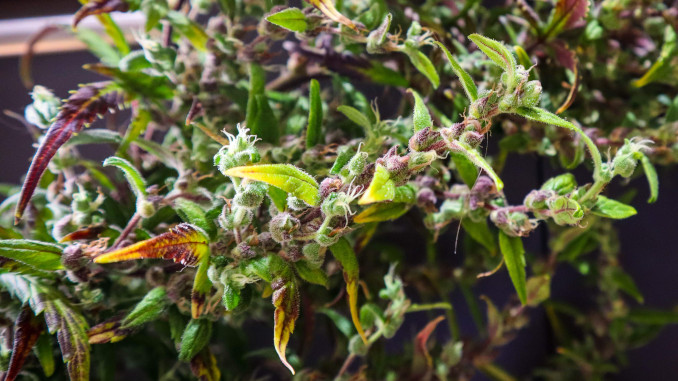

















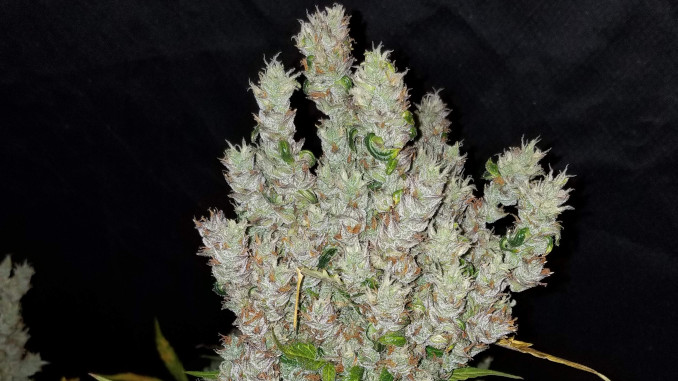
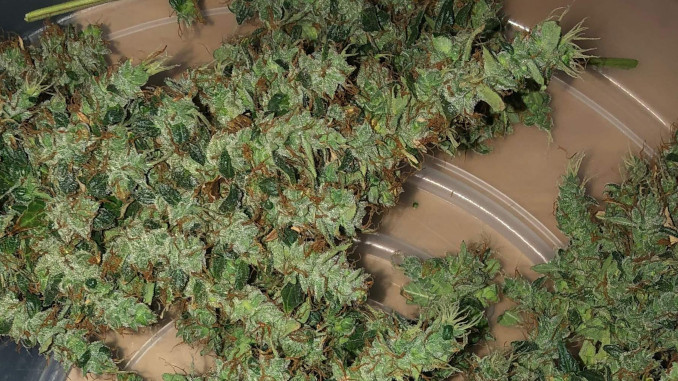
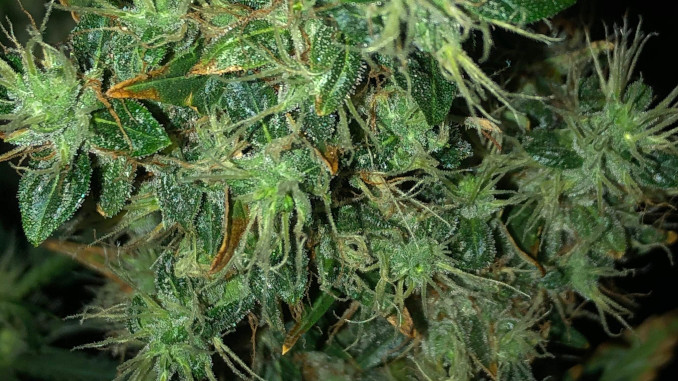
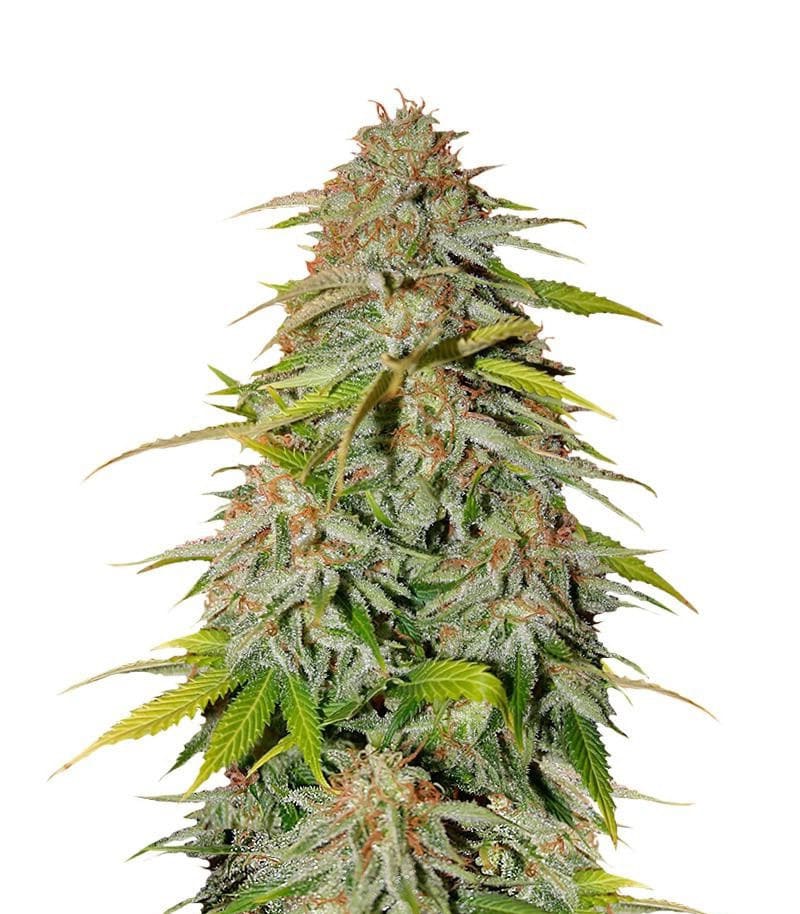
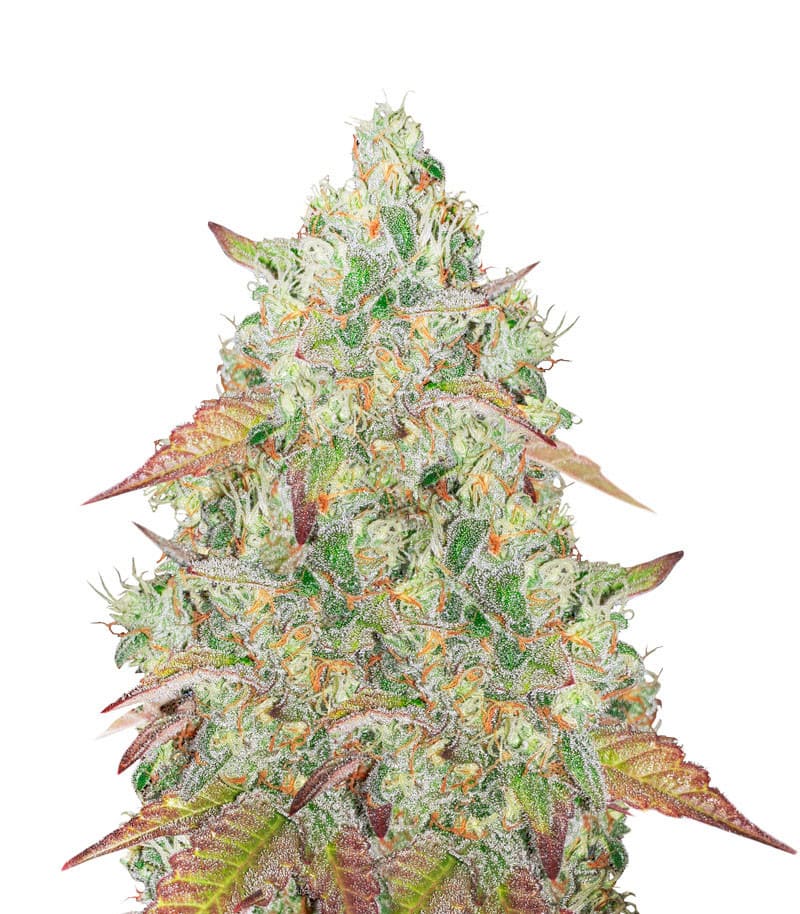
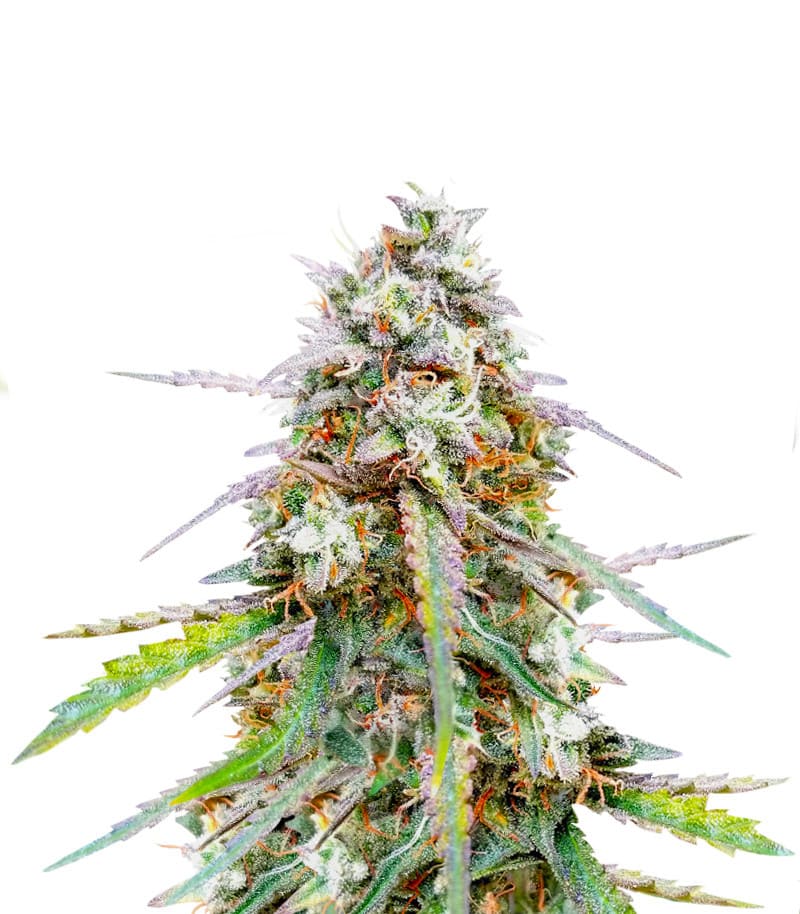
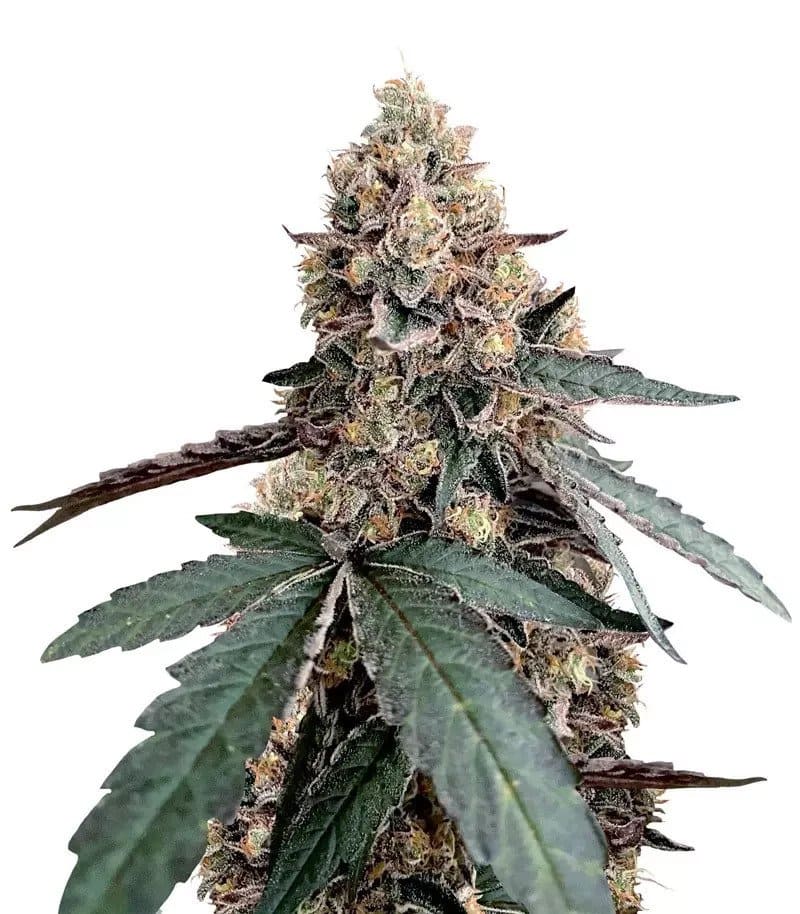
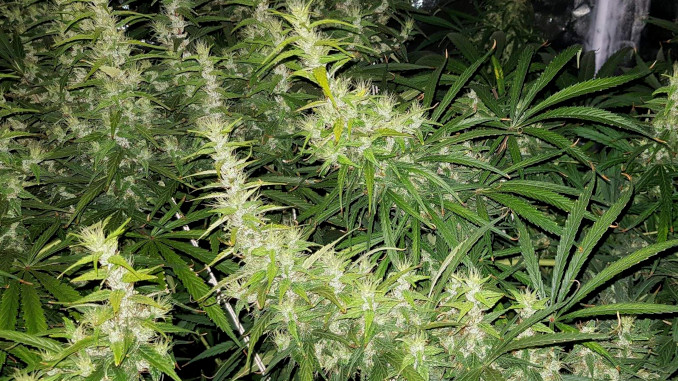
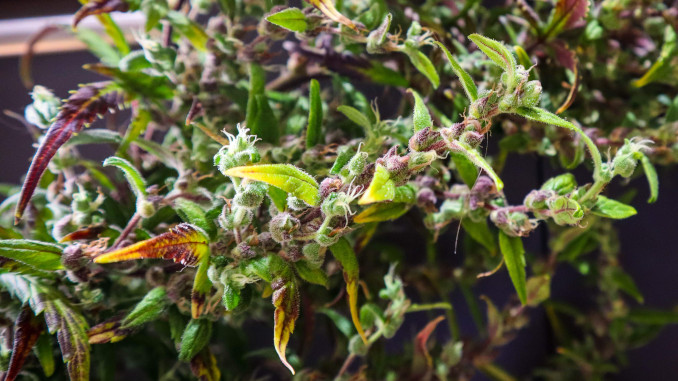
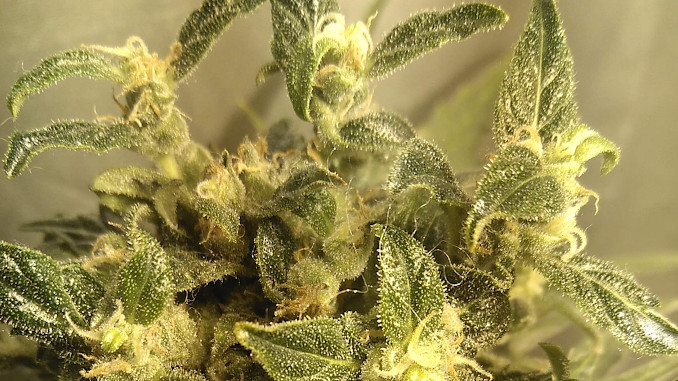
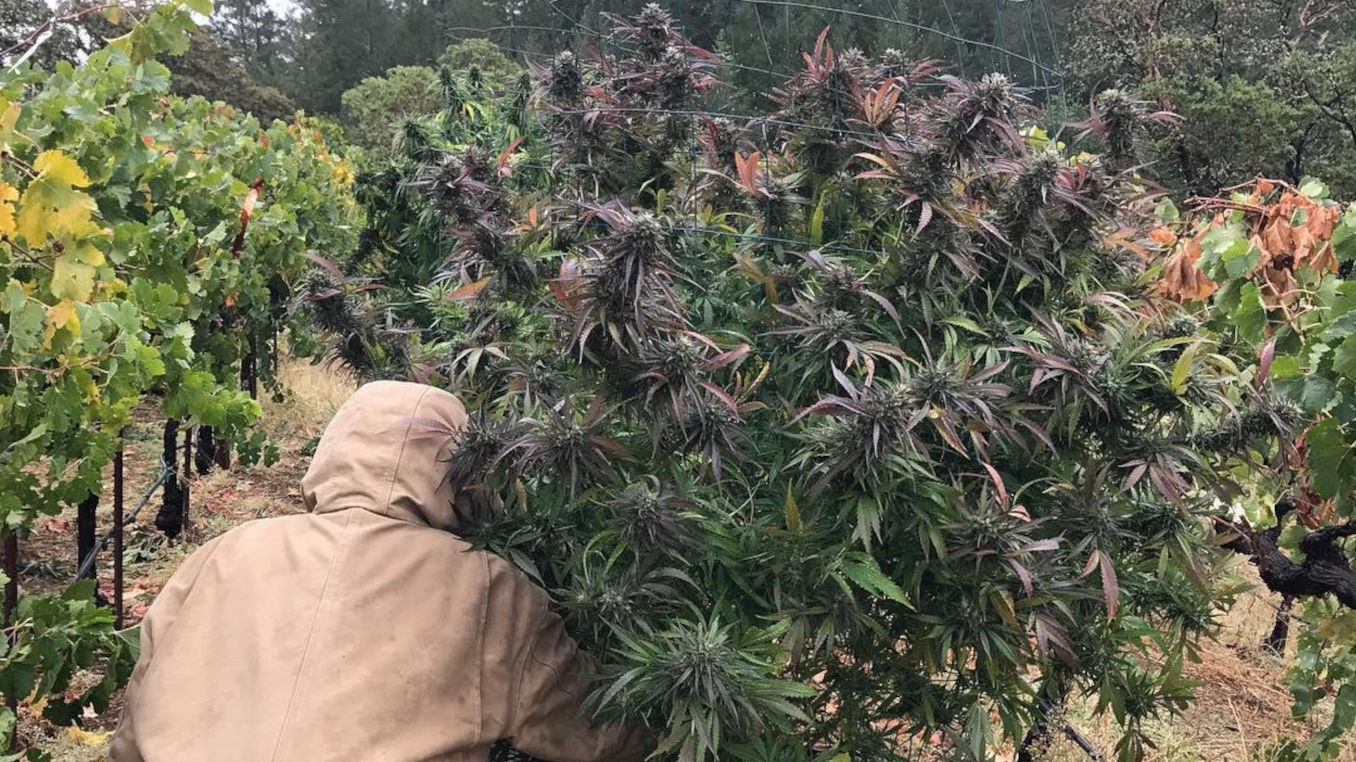
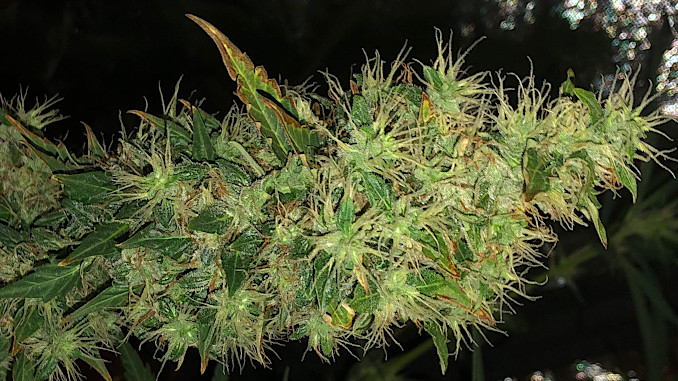








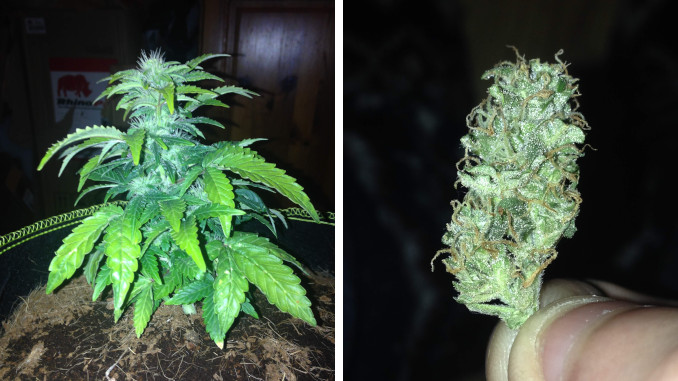
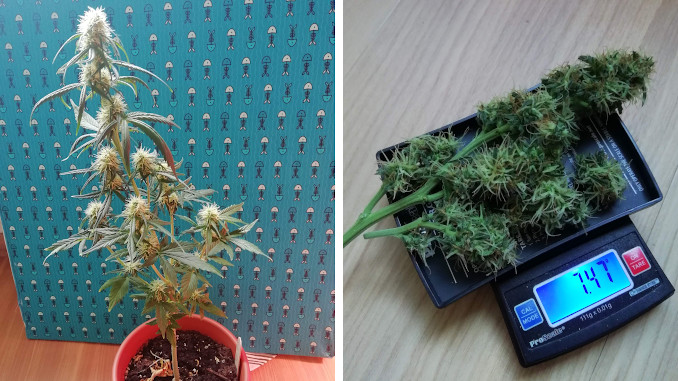















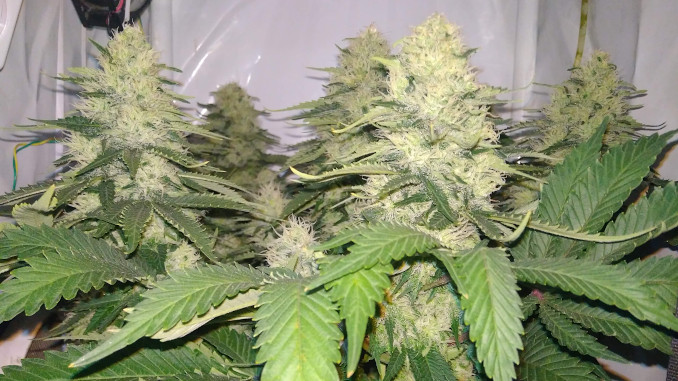




























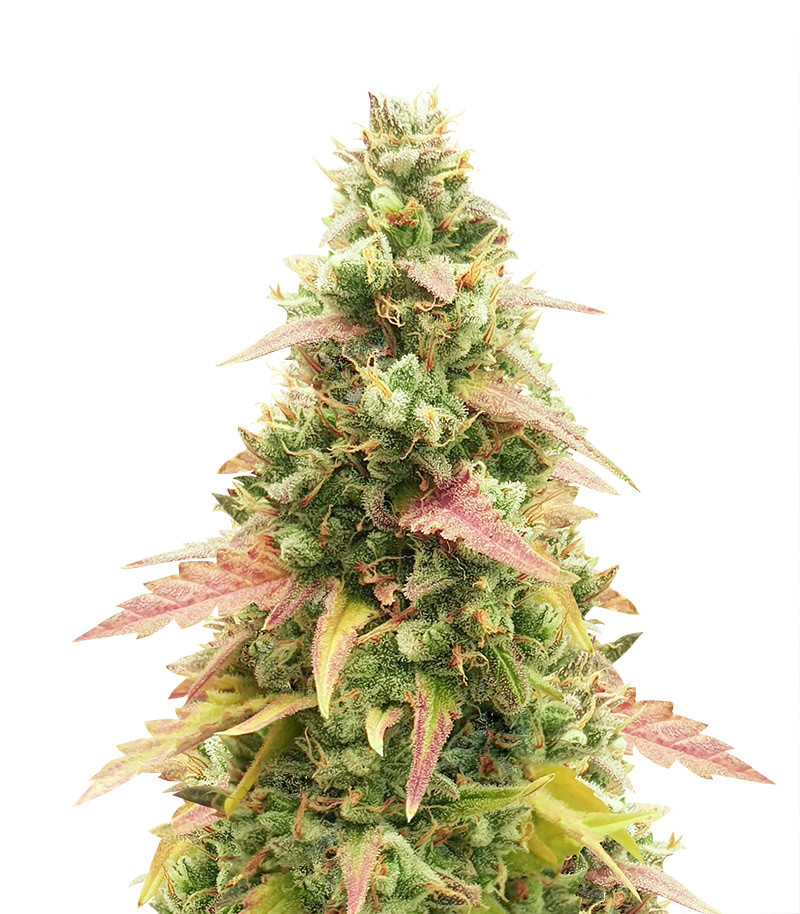
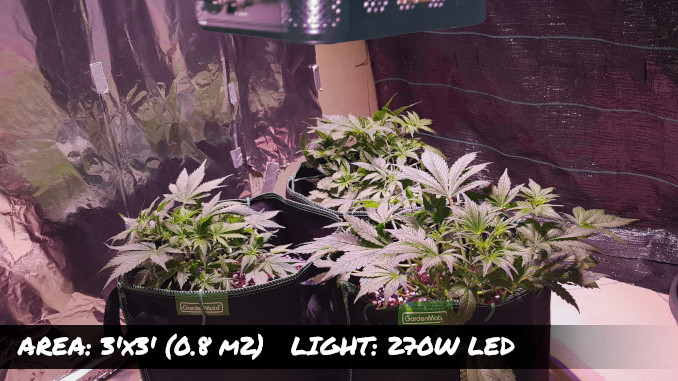
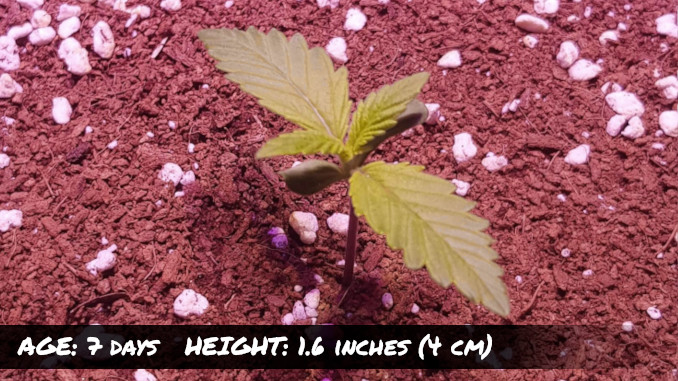
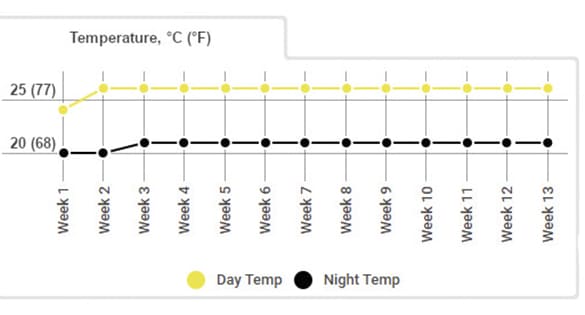
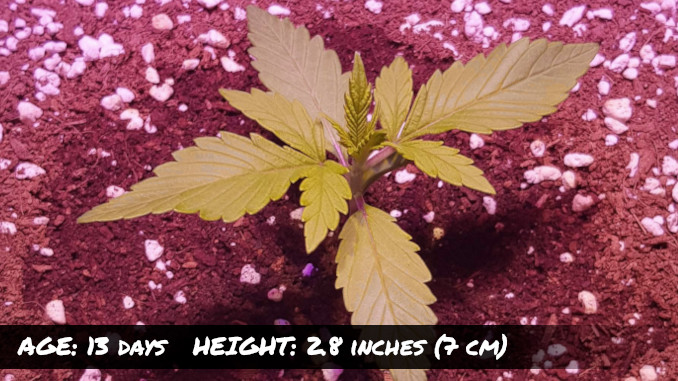
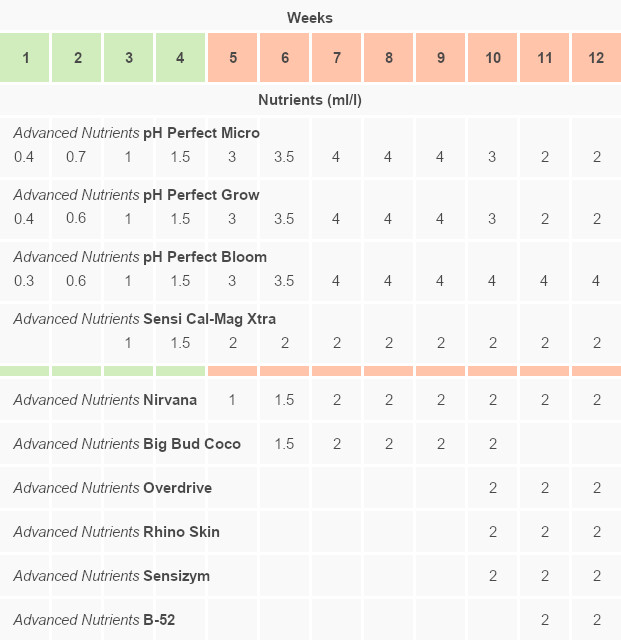
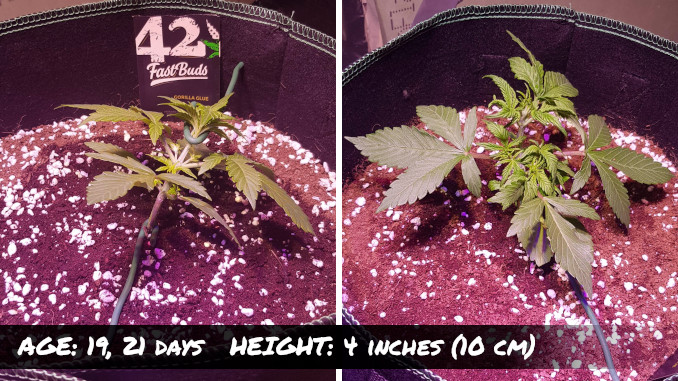
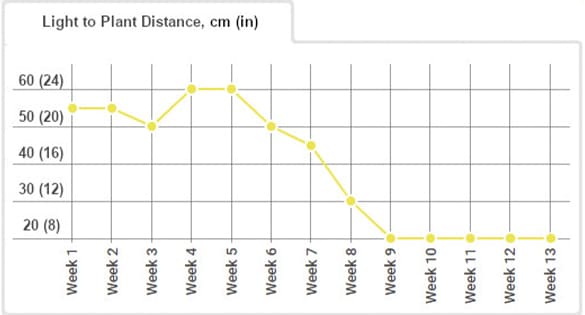
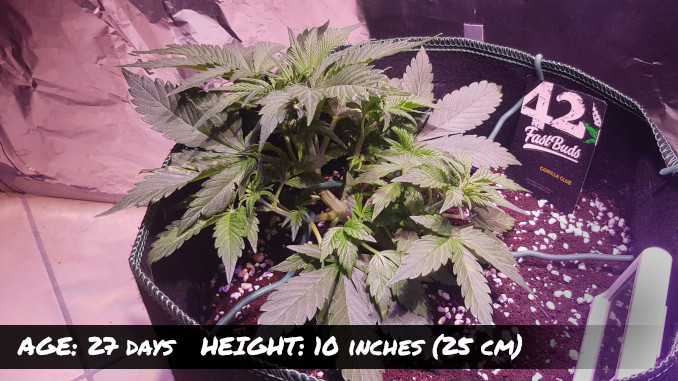

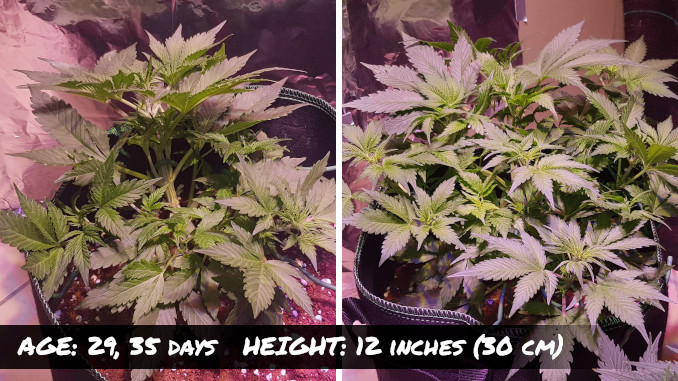
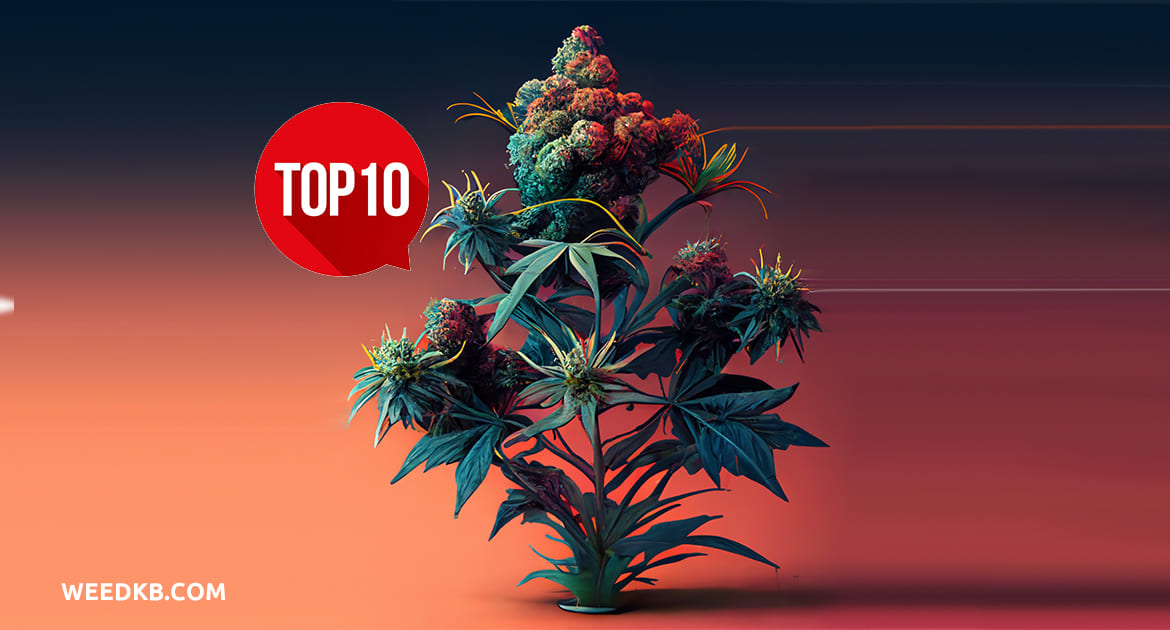
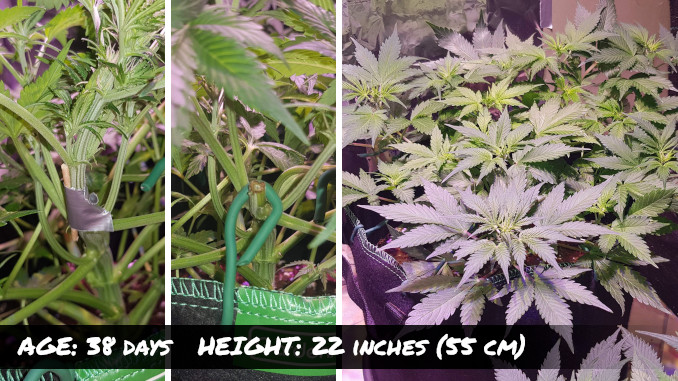
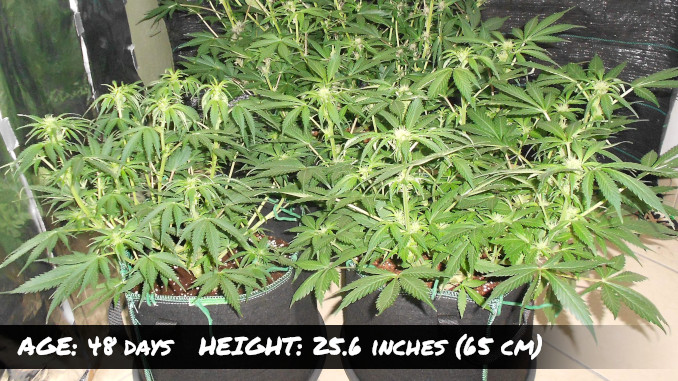
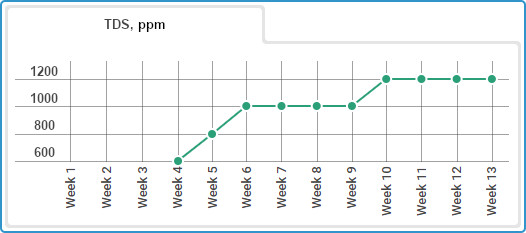
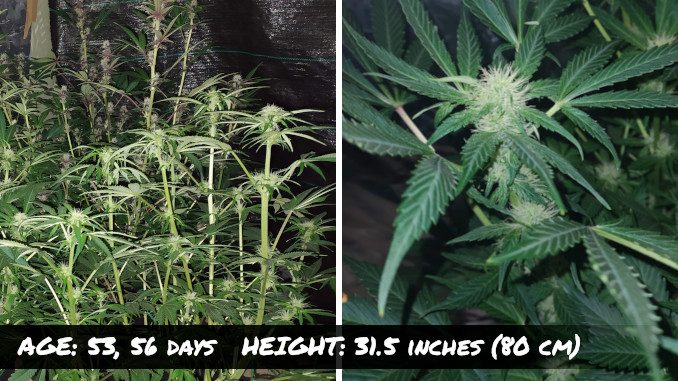
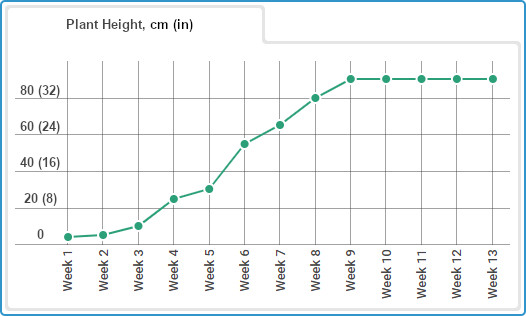
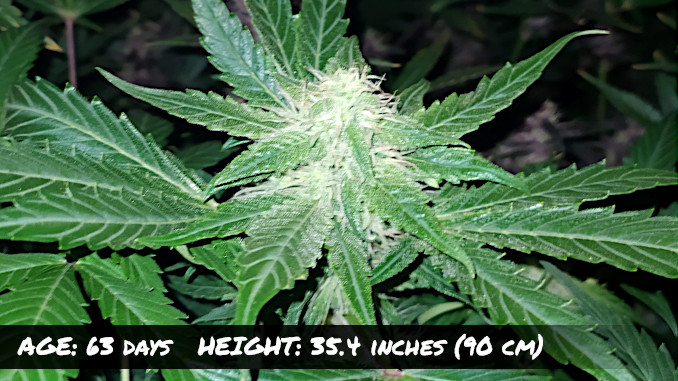

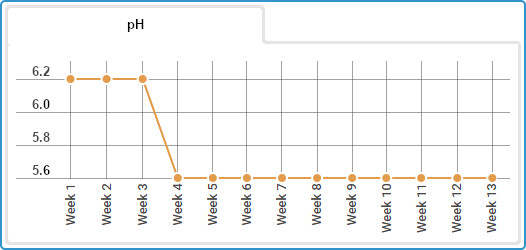
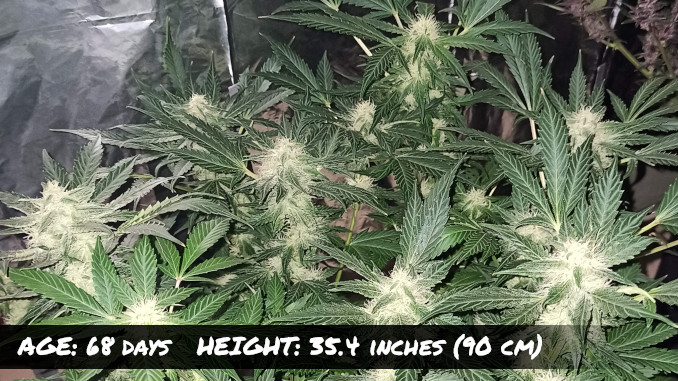
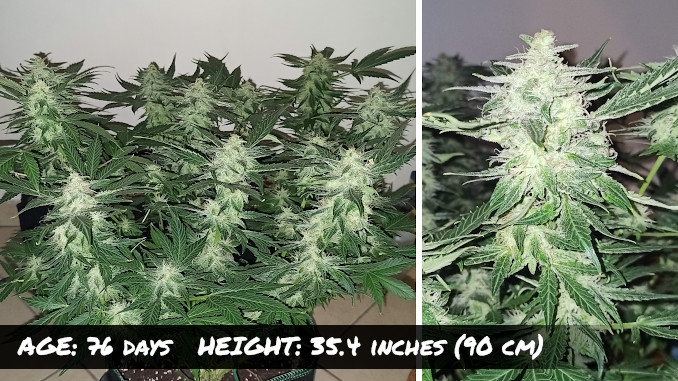
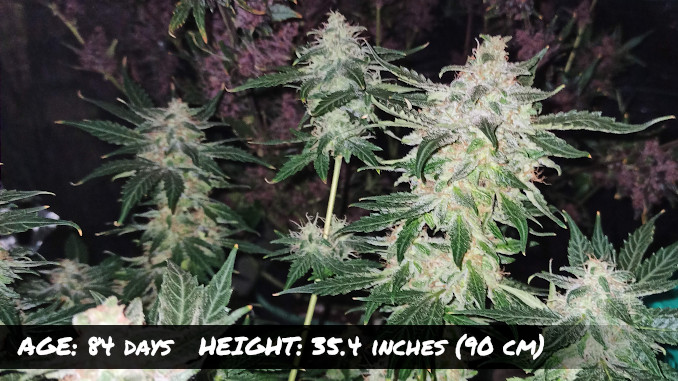
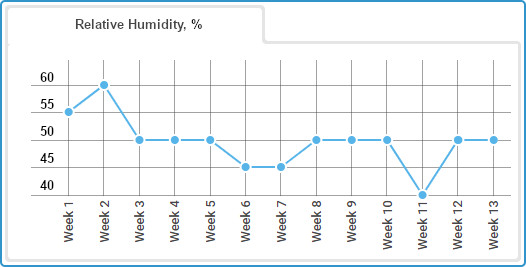
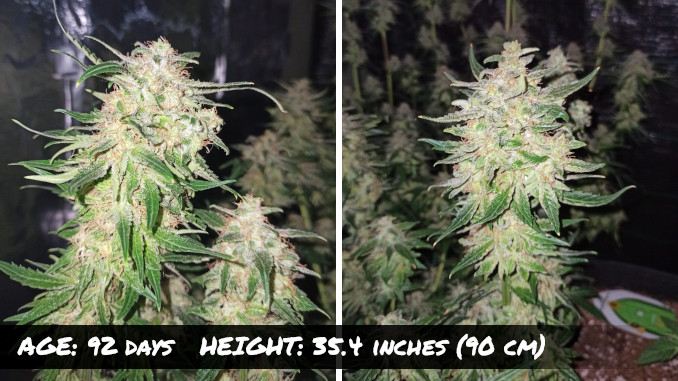
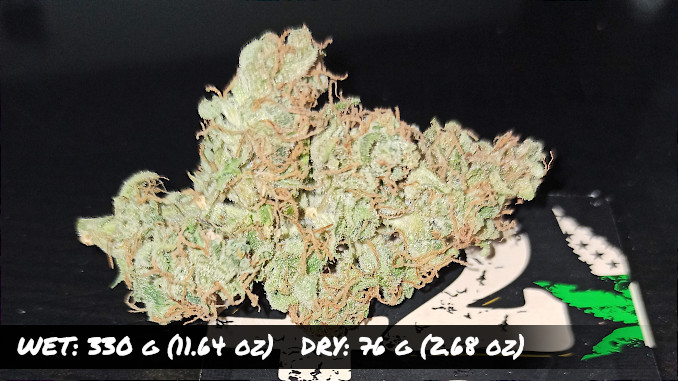
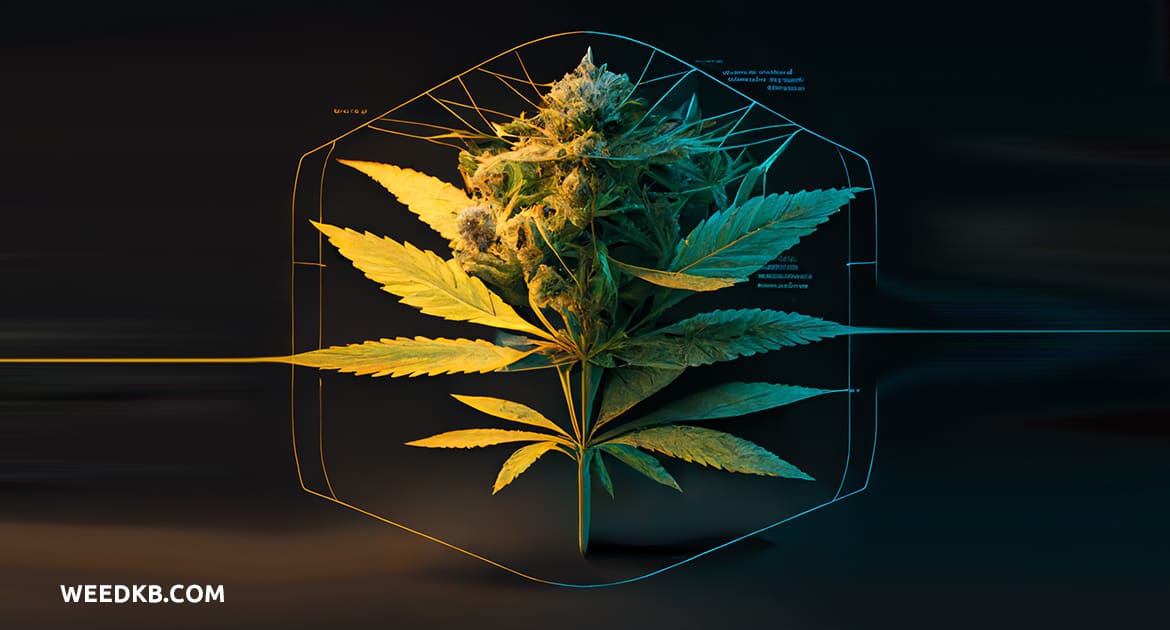
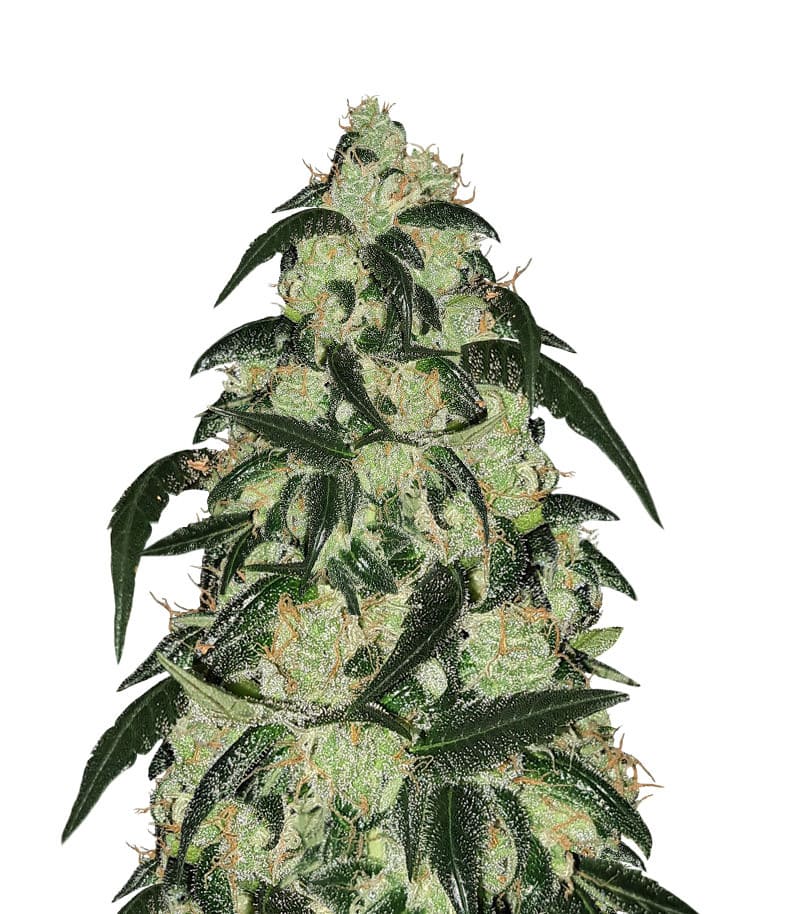
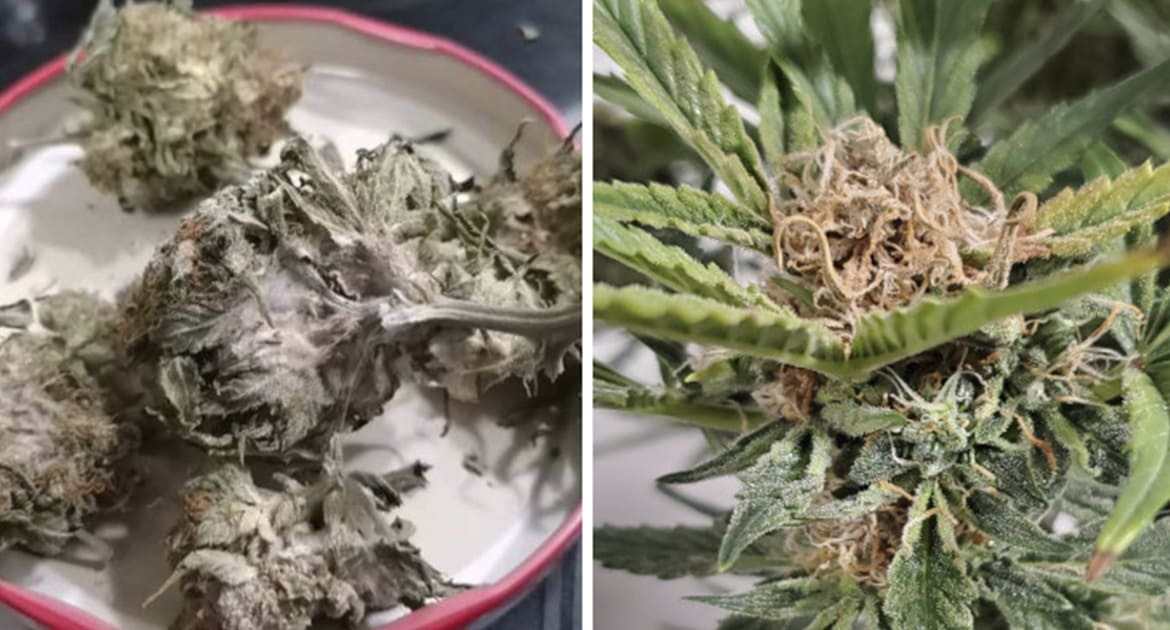
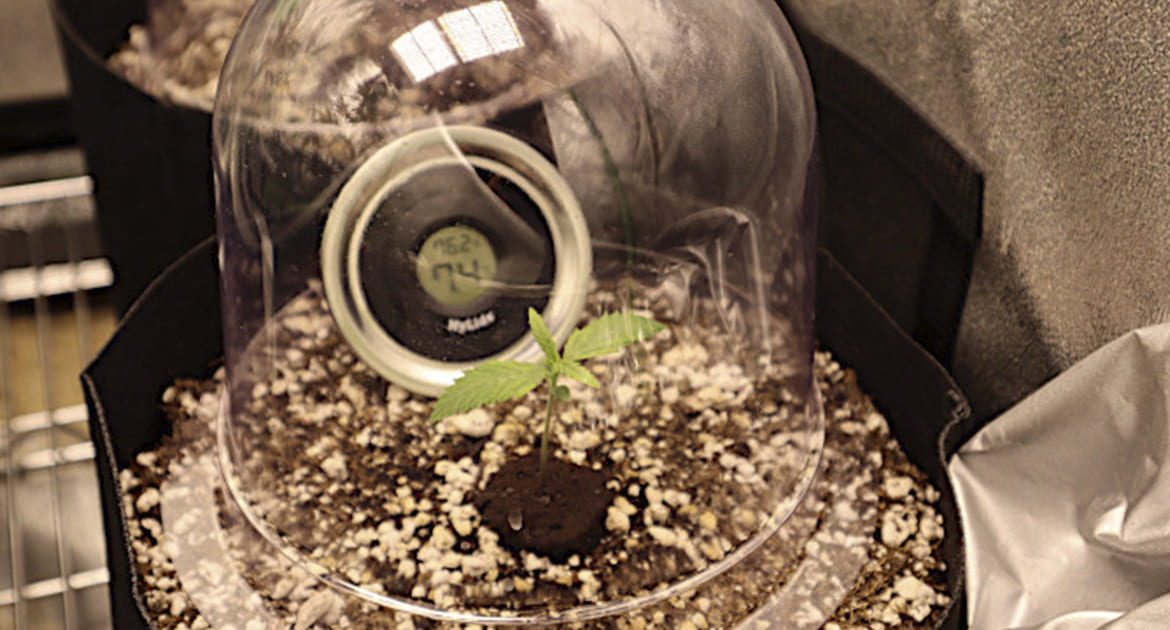
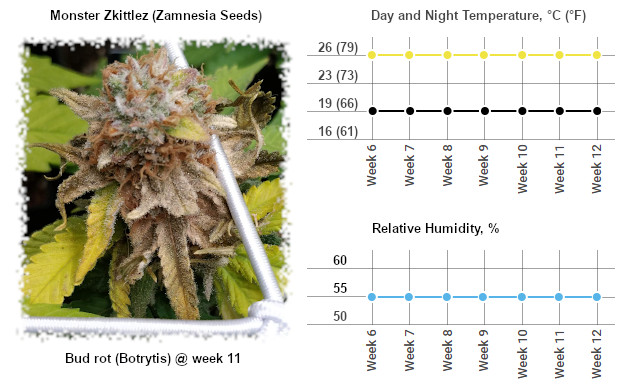 The grower kept the relative humidity too high (at 55%) in flower and discovered bud rot in week 11. Bud rot, or botrytis, is a kind of fungus that loves high humidity. As for temperature, botrytis thrives when it’s colder than normal or there is a sharp drop in temp between day and night. However, high temps coupled with high humidity may also cause bud rot.
The grower kept the relative humidity too high (at 55%) in flower and discovered bud rot in week 11. Bud rot, or botrytis, is a kind of fungus that loves high humidity. As for temperature, botrytis thrives when it’s colder than normal or there is a sharp drop in temp between day and night. However, high temps coupled with high humidity may also cause bud rot.  We can’t say that in this grow the temperatures and the humidity were really that wrong. The day temps might have been too high, and the difference between day and night too great. Also, the relative humidity could have been lower for the whole of the flowering stage, especially in the last couple of weeks. The mold probably appeared because the buds were so huge and dense, and the slightly wrong temp and humidity played their part, too.
We can’t say that in this grow the temperatures and the humidity were really that wrong. The day temps might have been too high, and the difference between day and night too great. Also, the relative humidity could have been lower for the whole of the flowering stage, especially in the last couple of weeks. The mold probably appeared because the buds were so huge and dense, and the slightly wrong temp and humidity played their part, too. 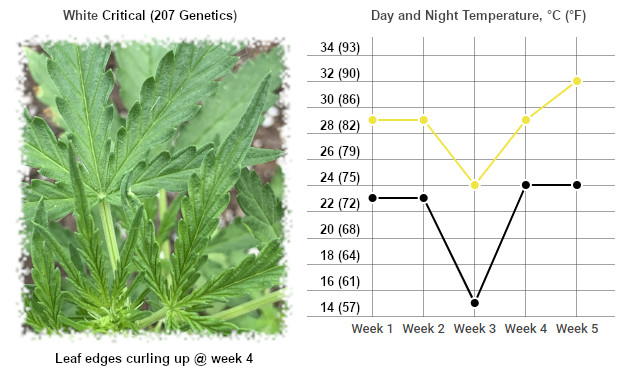 In this outdoor garden, there were several autoflowering and photoperiod strains, but only one plant reacted to summer heat with cupping leaves. This symptom is indeed very often the consequence of heat stress, but sometimes it is due to calcium deficiency. What is different about calcium deficiency is the presence of black spots on affected leaves.
In this outdoor garden, there were several autoflowering and photoperiod strains, but only one plant reacted to summer heat with cupping leaves. This symptom is indeed very often the consequence of heat stress, but sometimes it is due to calcium deficiency. What is different about calcium deficiency is the presence of black spots on affected leaves. 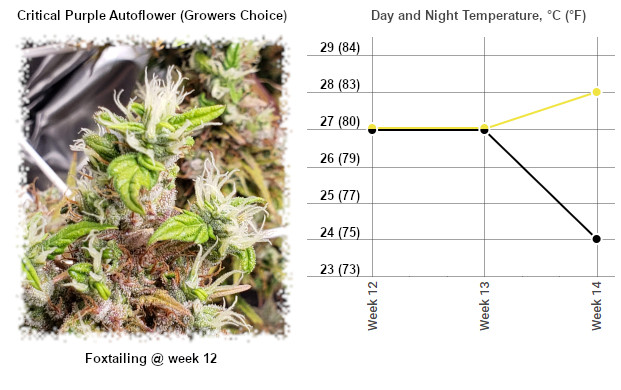 At the end of this grow, the temperatures ran out of control. Especially the night temperatures which were the same as day temps for two weeks. And that was the most likely reason for foxtailing which is the growth of new elongated shoots on maturing buds.
At the end of this grow, the temperatures ran out of control. Especially the night temperatures which were the same as day temps for two weeks. And that was the most likely reason for foxtailing which is the growth of new elongated shoots on maturing buds. 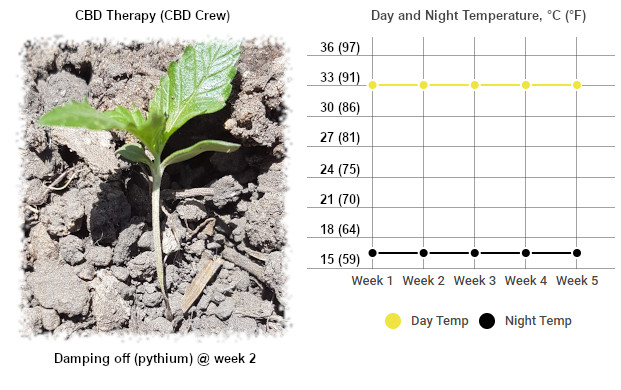 The grower made a mistake of planting his outdoor garden in the middle-of-July heat. At the same time, the nights were rather cool. This temperature stress weakened the seedlings and made them susceptible to pythium, aka damping off. As a result, the stems just above the soil thinned and the seedlings fell over.
The grower made a mistake of planting his outdoor garden in the middle-of-July heat. At the same time, the nights were rather cool. This temperature stress weakened the seedlings and made them susceptible to pythium, aka damping off. As a result, the stems just above the soil thinned and the seedlings fell over.  In this outdoor run, the autoflowers were finishing in the middle of autumn when warm days and cool nights led to the dew forming on leaves and causing powdery mildew. The grower didn’t monitor the relative humidity of the air, but it doesn’t matter. When the dew forms, it means the RH is 100%.
In this outdoor run, the autoflowers were finishing in the middle of autumn when warm days and cool nights led to the dew forming on leaves and causing powdery mildew. The grower didn’t monitor the relative humidity of the air, but it doesn’t matter. When the dew forms, it means the RH is 100%. 